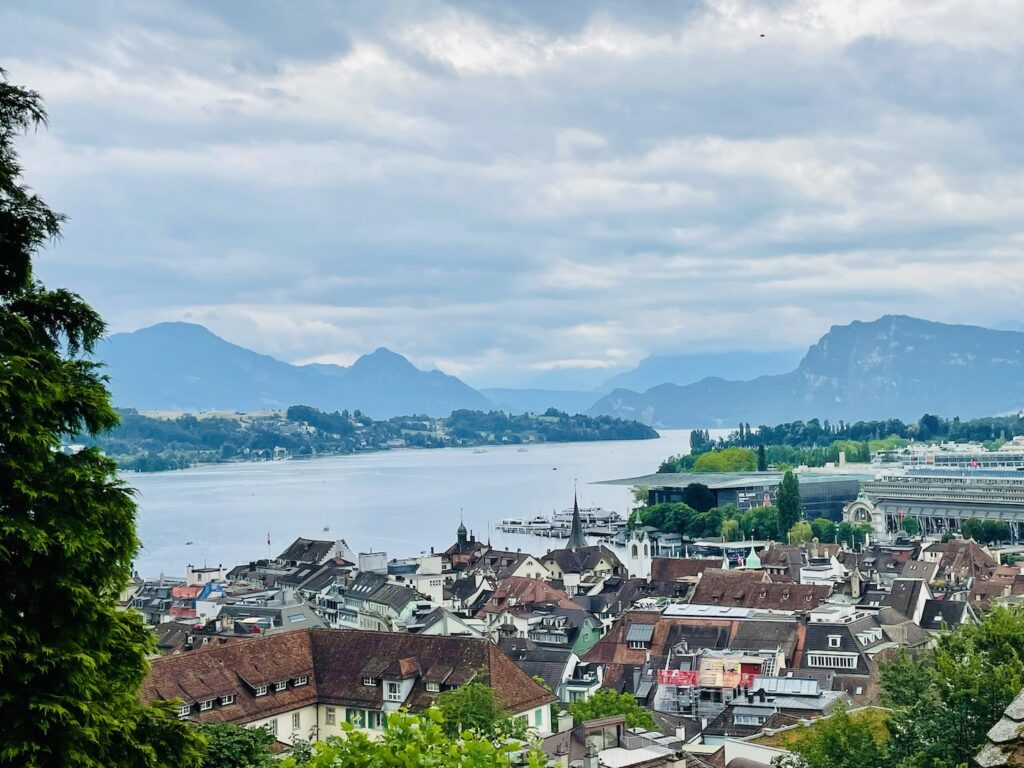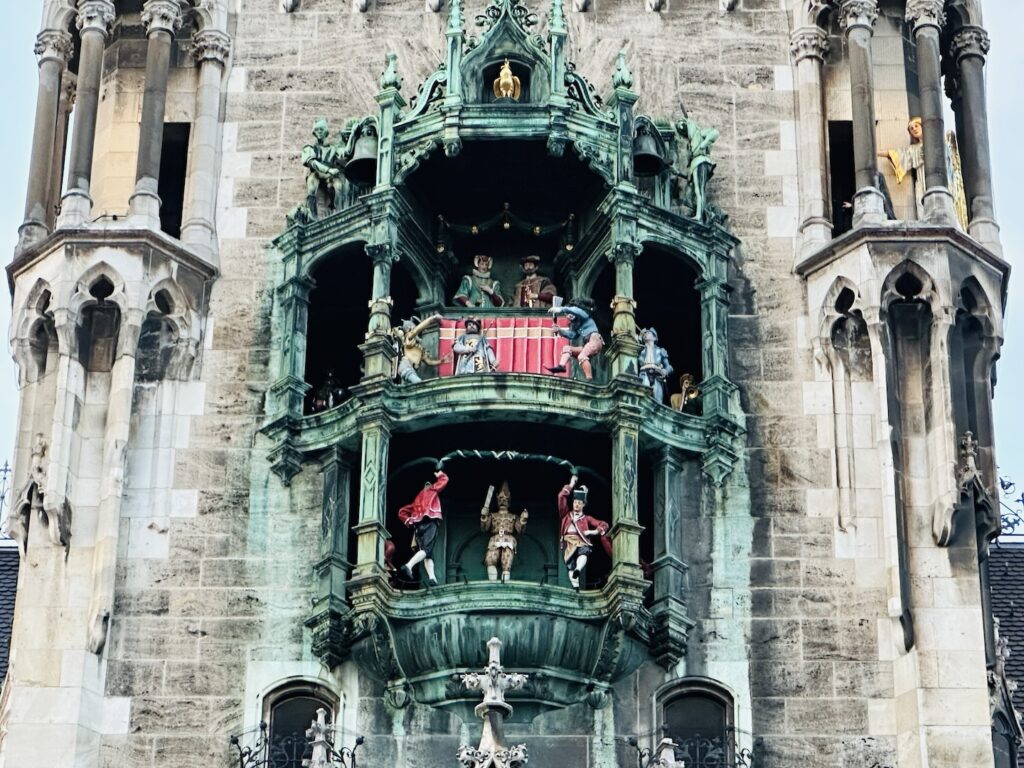Majestic mountains, alluring turquoise lakes, massive glaciers. The Canadian Rockies has them all, and they are amazingly beautiful. Photographs and words try hard, but they can’t adequately express the truly spectacular scenery here. Our trip spanned 13 days that included driving (a rental car) and hiking in the Canadian Rockies (in and around Banff, Lake Louise, and Jasper), two days relaxing on a Rocky Mountaineer luxury train that carried us westward, and several days to leisurely explore Vancouver and Victoria, two beautiful coastal cities on the western edge of the continent. You could easily shorten or extend this itinerary by a day or more, depending on your interests and what you want to see and do. Planning is key to making your trip a success. This post will help you decide what to see and do in the Canadian Rockies — and how to get from place to place.
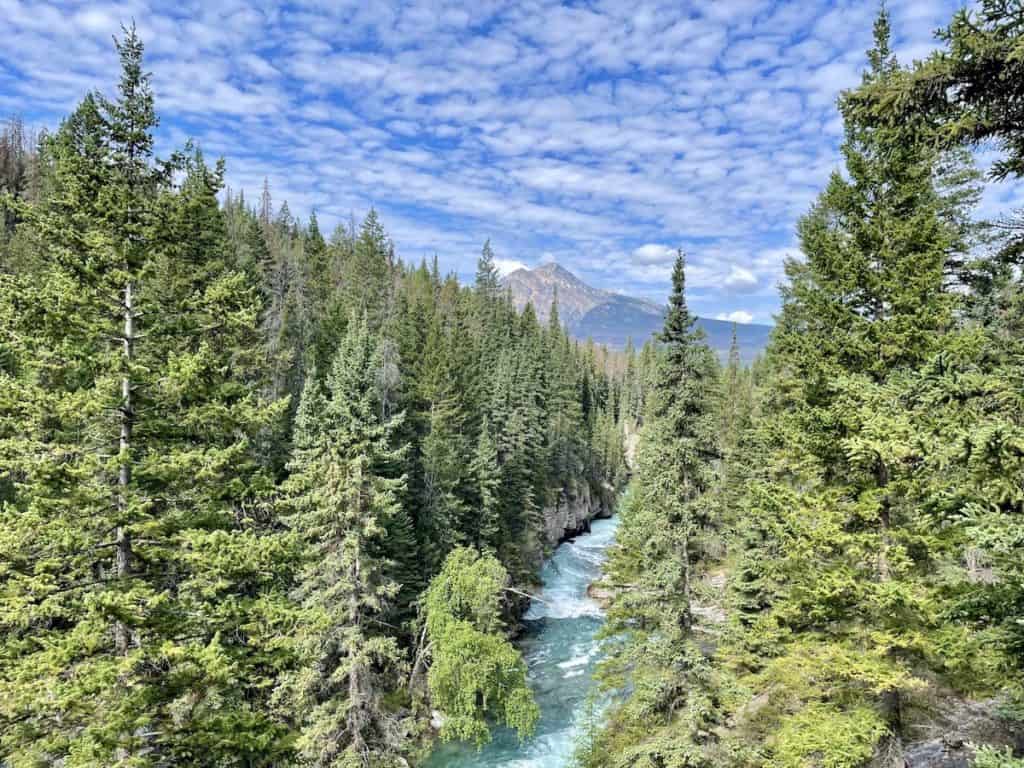
DISCLAIMER: My husband and I have enjoyed special experiences and stays in our travels, but a few stand out above the rest — this is one of them. Please note that we have not accepted free trips, endorsements, or gratuities from anything mentioned in this post. Happy travels!
Rocky Mountaineer Options
My husband and I booked this trip through Rocky Mountaineer, a company that has several inviting train routes through the Canadian west (and in the American west, too). The Journey through the Clouds (with self-drive option) package we chose included two days on the train itself along with a rental car for exploring the main towns of the Canadian Rockies (Banff, Lake Louise, and Jasper) on our own. In addition, Rocky Mountaineer scheduled our accommodations, with the Goldleaf Service level (our selected option), at lovely Fairmont hotel/resort properties. Once we selected what route and package we wanted, we moved ahead with planning. We actually had a lot of time on our own — 11 of the 13 days of the trip.
Although the train, hotels, and rental car are booked through Rocky Mountaineer, there is a lot of room to customize the experience. We like to hike, so we incorporated some amazing treks into our adventure. By exploring on foot, we experienced the true beauty of the landscapes. For us, viewing the mountains and canyons is one thing, but hiking them made us appreciate this wilderness so much more.
Canadian Rockies Landscapes, Wildlife & Recreation
The mountains are composed of limestone and shale rock, and the valleys are often u-shaped, formed by glaciers. The beautiful turquoise hue of the lakes was drop-dead gorgeous. That unique look is due to glacial rock particles which have flowed into the lakes that then work with the sunlight to produce such vivid color.
There are over 50 species of mammals and over 260 species of birds in the Canadian Rockies. You may be lucky enough to see grizzly bears, big horn sheep, and bald eagles on the trip. Be mindful, though, that you are visiting their habitats — their homes. The unwritten rule is that if you cause an animal to move, you are too close to them.
Canadian Rockies Outdoor Fun
The Canadian Rockies serve up a lot of recreation options. Do some online searches to find what activities and locales suit you best. You have your choice of boating, golfing, fishing, hiking, horseback riding, mountain biking, swimming, and white-water rafting.
Go for a Hike!
When you’re in the Canadian Rockies, you’ll no doubt want to experience the beauty on foot. There are quite a few hiking options. They range from easy to more difficult treks. Keep in mind that the ones rated easy can be busy with tourists. Perhaps a moderately rated one would be an option — unless you’re a seasoned hiker and are ready for more challenging trails. Check online for hiking information to choose what suits you best. (I use AllTrails, an app with hiking maps and guides, to help me find trails that we want to try.)
Our Canadian Rockies Itinerary
We flew into Calgary; rented a car; drove to Banff, Lake Louise, and Jasper over six days; traveled from Jasper to Vancouver aboard a Rocky Mountaineer luxury train for two days; and enjoyed a few days exploring Vancouver and Victoria (on Vancouver Island).
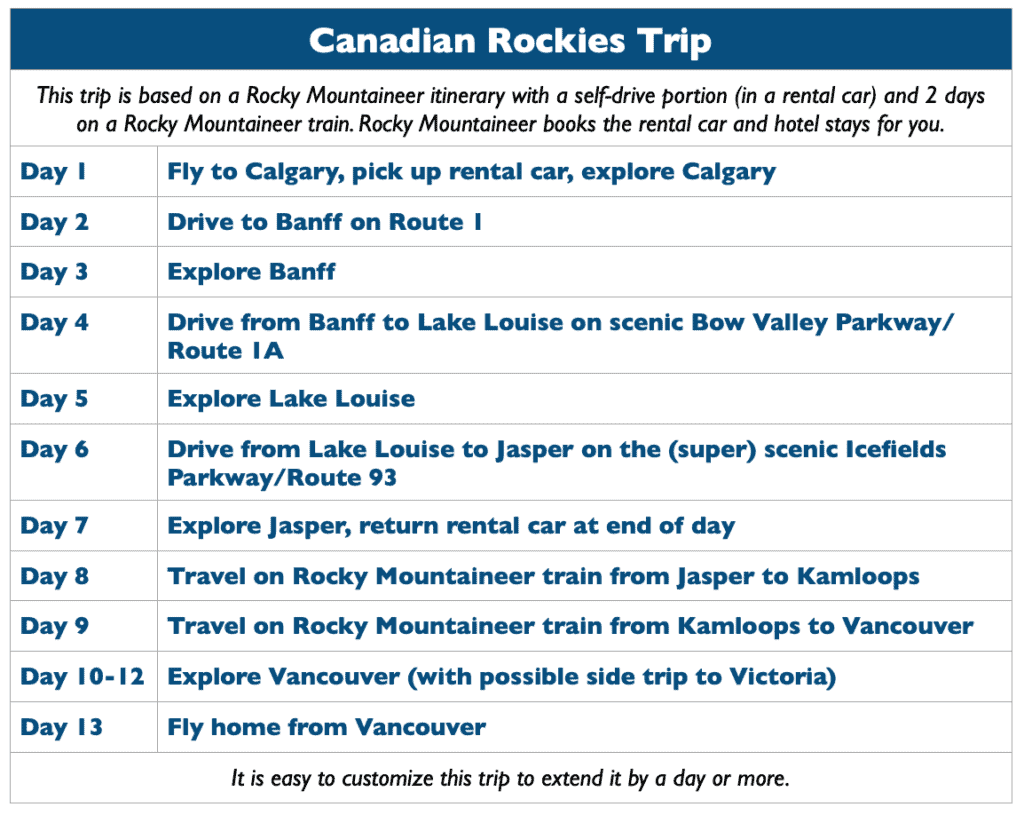
We covered a lot of miles on this journey as we traveled from western Alberta all the way through British Columbia to its coastline.
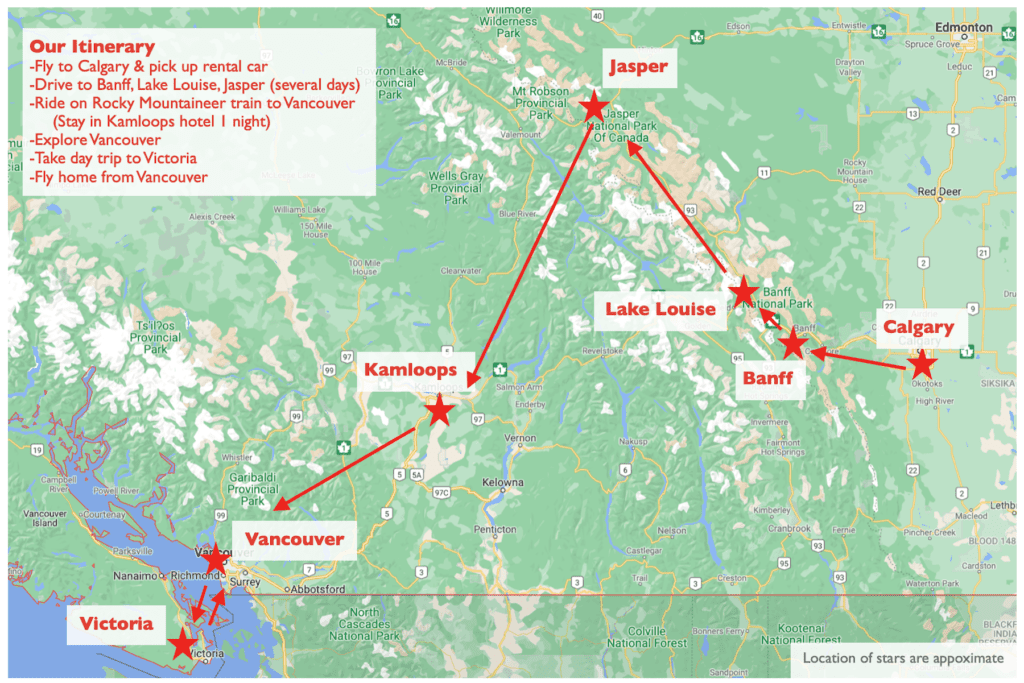
The Self-Drive Tour from Calgary to Jasper
We found the best way to explore the Canadian Rockies is to rent a car and drive from place to place. By driving, you have the ultimate flexibility in where you want to stop to take in views, have a picnic lunch, or explore a bit more on foot. This part of the journey requires some pre-planning (at least several weeks before leaving home) coupled with advice from hotel concierges (after checking into hotels). Keep in mind that you should keep your fuel tank happy and top it off when you see gas stations in towns (as you’ll be driving through some unpopulated areas in the Rockies).
One thing that enhanced our driving journey was using the GyPSy audio guide. It’s like having a tour guide in the car! It’s completely GPS driven (no WiFi or cell service needed). When driving near a point of interest, the narrator talks about it, giving context to what is outside the car window. We learned about the geological beginnings of the mountainous region as well as the early explorers in the area along with details about specific landscapes. Oh, and the narration was spot-on when suggesting we park the car and get out to take in a particular view.
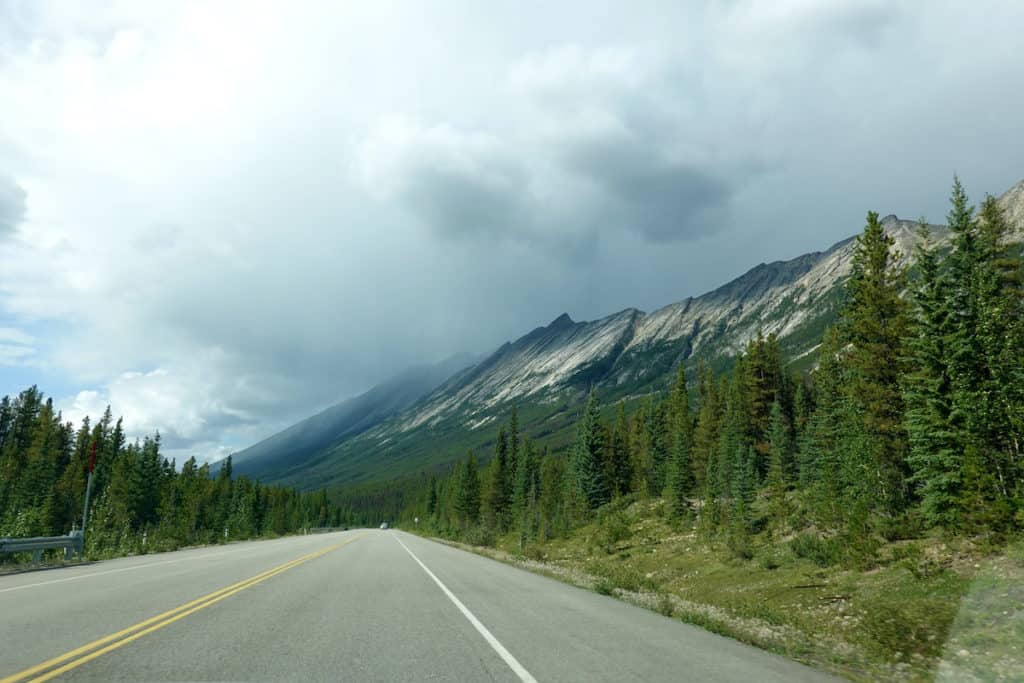
Driving Times
Assuming you’ll want to pause along the way to park the car to get out and take in the incredible views, these drive times are the minimum you should plan on.
- Calgary to Banff – 80 miles/128 kilometers, 90 minutes without stopping
- Banff to Lake Louise – 35 miles/56 kilometers, 50 minutes without stopping
- Lake Louise to Jasper – 145 miles/233 kilometers, 3 hours without stopping (we spent over 8 hours!)
Calgary
Calgary is a good starting point for this westward trip and has many flight connections from the U.S. and other parts of Canada. Situated on the eastern foothills of the Canadian Rockies in Alberta, Calgary has a long history in the oil, ranching, and meatpacking industries — hence its nickname of Cowtown. Today its population of about 1.5 million makes it the fourth-largest metropolitan area in the country. If spending a day or two in Calgary, you may want to check out the Calgary Tower; Calgary Zoo; Botanical Garden & Prehistoric Park; the Canada Olympic Park; Heritage Park Historical Village; and TELUS Spark Science Centre.
Driving from Calgary to Banff
The 80 miles/128 kilometers from Calgary to Banff takes about 90 minutes to drive along Route 1 (Trans-Canada Highway). Since the town of Banff is in Banff National Park, you’ll need to purchase a park pass. (Buy your ticket online before your trip and that’s one less thing you need to think about.)
Mostly open prairie land lies between Calgary and Banff with a few developments here and there. As you proceed through this prairie landscape, you begin to see rolling hills, and then the Canadian Rockies emerge before your eyes. At about the 60th mile/97th kilometer, you’ll see Canmore, a town that offers something for adventure seekers (such as biking, hiking, horseback riding, and skiing) as well as others who prefer to stroll the town, visit galleries, shop, and enjoy a relaxing meal.
Banff
Banff is a resort town of close to 10,000 permanent residents. The town was named after Banff, Scotland which was the birthplace of the Canadian Pacific Railway (CPR) president in the late 1880s. Actually, CPR played an important role in the town’s history. It was the railroad that build some magnificent hotels along its tracks that linked the western British Columbia province with the provinces in the east. Those hotels were considered resort destinations for travelers to enjoy along the train route. The Fairmont Banff Springs hotel is one of those grand hotels — and a wonderful place to stay today. (The Fairmont Chateau Lake Louise is another one of these magnificent hotels built by the CPR.)
The high points of our stay in Banff were:
Cave and Basin National Historic Site
The country’s national park system began at the Cave and Basin National Historic Site in the 1880s when this became a national reserve. Today you’ll find warm mineral springs in the cave, an emerald-green basin outside, hiking trails, and plenty of displays telling the story of this place.
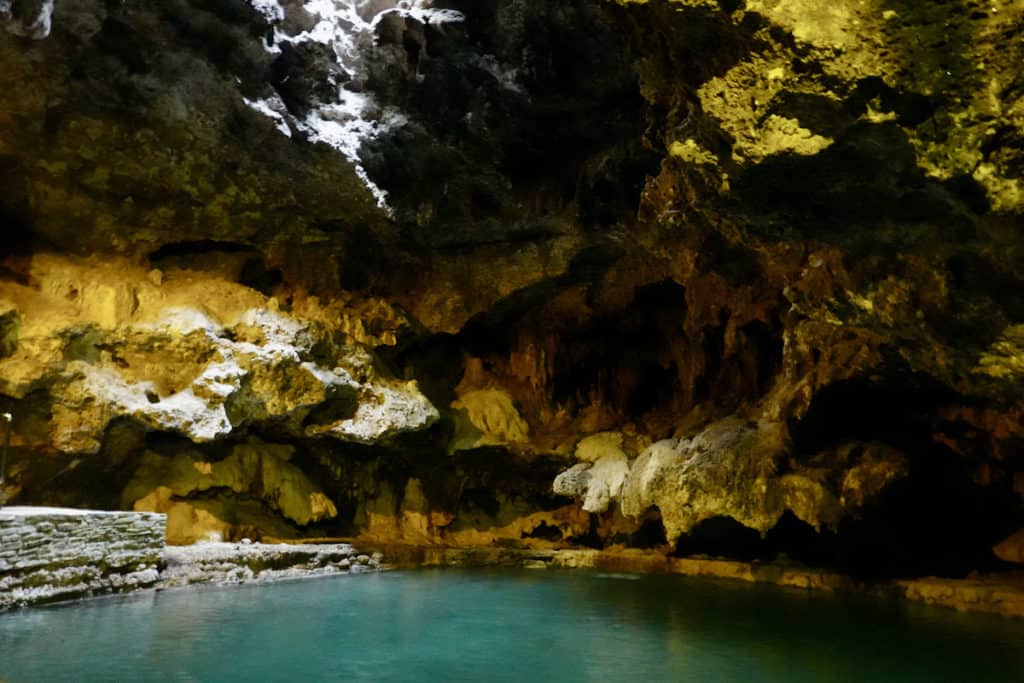
Also included here is an exhibit on the internment camp built and used in this area during World War I. It was those prisoners (called “enemy aliens”) who worked on many of the roads, trails, and other groundwork for this national park.
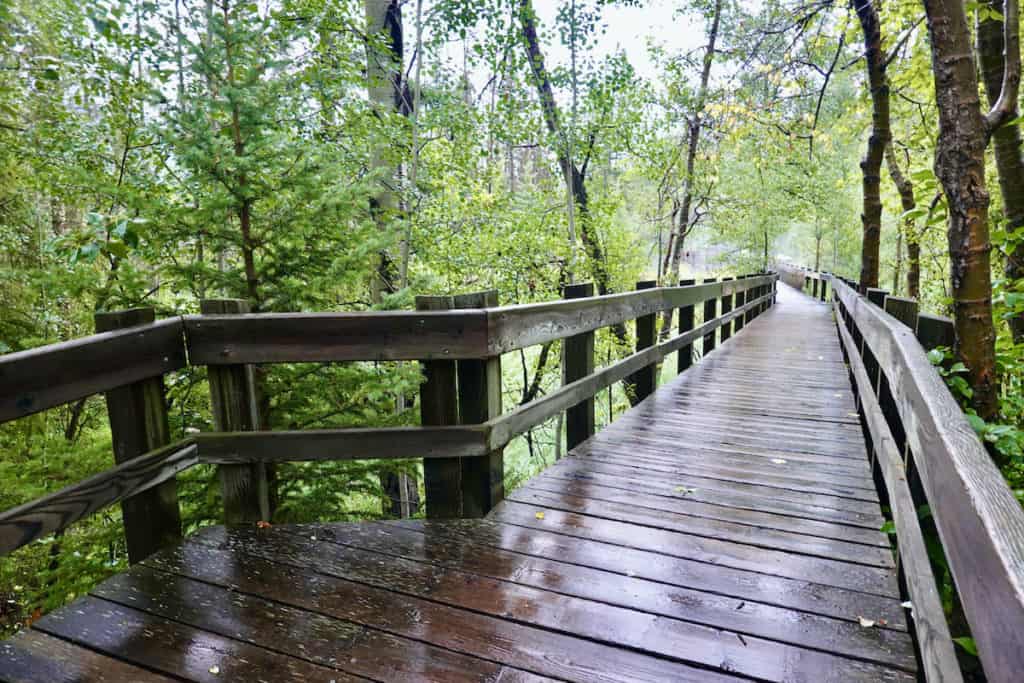
There are a few trails to enjoy at the Cave and Basin National Historic Site. A boardwalk trail takes you on an elevated trail through a wooded area over the marshland below. It’s an easy walk.
Surprise Corner Viewpoint
This short stop along Buffalo Street, uphill from town, has a platform with stairs that, once at the top, offers a beautiful view of the stately Fairmont Banff Springs hotel (which looks like a castle) and surrounding area.
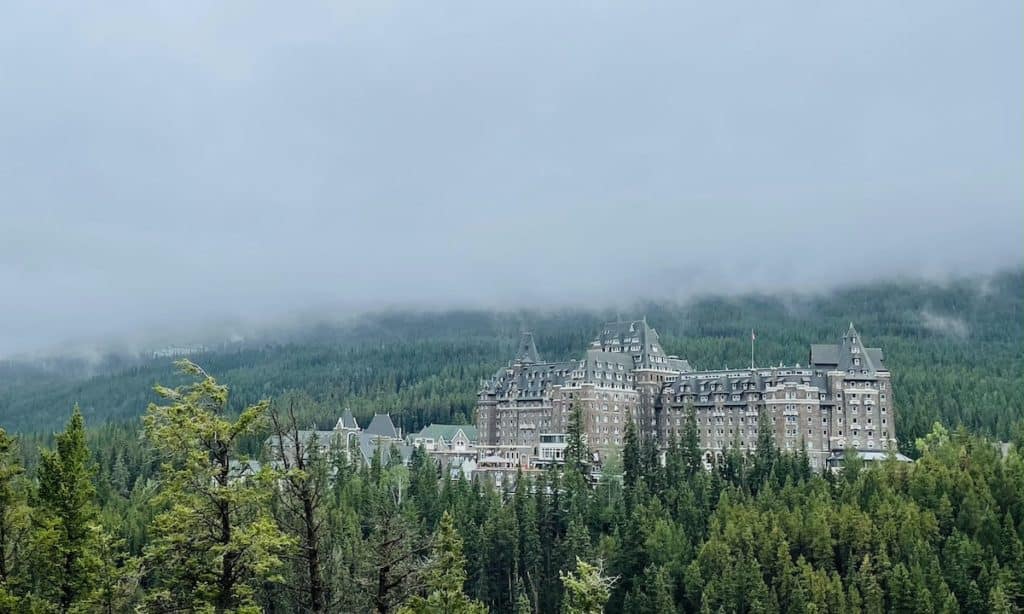
Tunnel Mountain Summit Trail
A hike up Tunnel Mountain offers great views of the Bow Valley, the town of Banff, and towering Mount Rundle. The trail becomes a switchback and is a little steep in some places with some loose stones, but it’s manageable. We started at the small parking lot along Tunnel Mountain Road to keep our hike short enough to have time to explore other areas that day. (You could begin this hike in town which would take a bit longer.) In total, this is a 2.5 mile/4 kilometer out-and-back trail. If you have hiking poles, they may come in handy, though they’re not necessary.
Tunnel Mountain Bench Loop & Hoodoo Lookouts
Located further up Tunnel Mountain Road, this is a mostly paved trail with five lookouts, each one offering magnificent views of Mount Rundle which stands 9,672 feet/2,948 meters high, Tunnel Mountain which is 5,551 feet/1692 meters high, and the Bow Valley. Also, there are several hoodoos — tall, spiked, light brown rocks that seem to grow out of the ground.
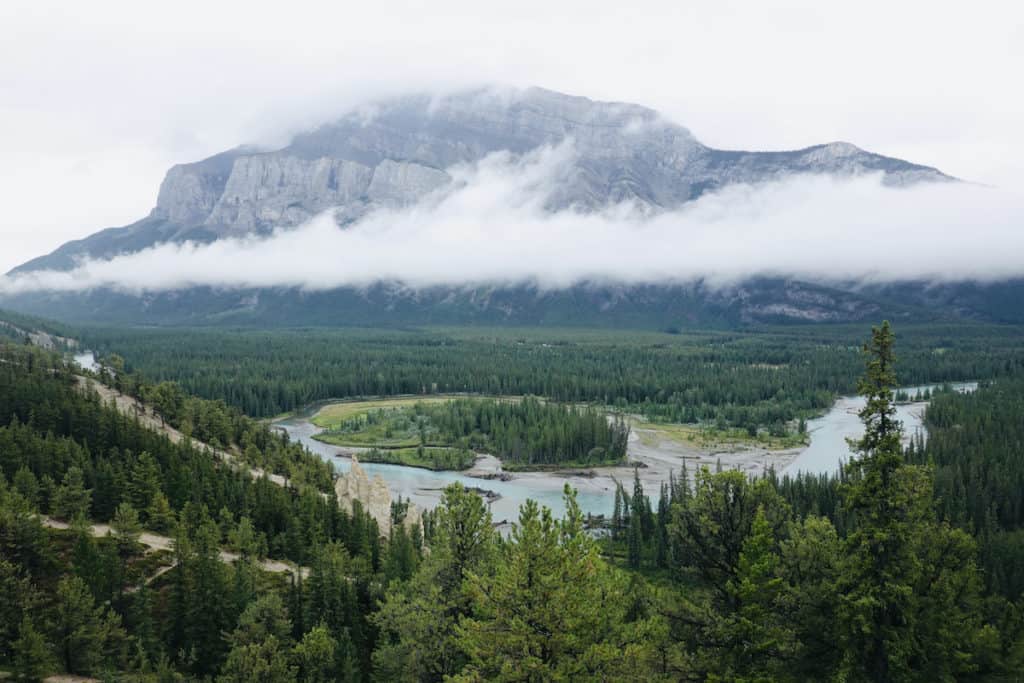
Lake Minnewanka Cruise
Enjoy a one-hour cruise along Lake Minnewanka (known as “Lake of the Water Spirits” by the First Nations people) on your way into Banff or on a free day here. Drive to the dock (about 15 minutes from downtown Banff), board the boat, and relax while soaking in the incredible views and listening to a commentary about the history of the area. Lake Minnewanka is the largest lake in Banff National Park at over 17 miles/27 kilometers long and is the only lake in the park that offers public motorized boating.
Also very popular with visitors are the Banff Gondola, the Banff Upper Hot Springs, and the Whyte Museum of the Canadian Rockies.
Driving from Banff to Lake Louise
There are two main choices for how to travel from Banff to Lake Louise. One is to continue on Route 1 (Trans Canada Highway). Another is to opt for the more scenic Route 1A (Bow Valley Parkway). Route 1A runs parallel to Route 1; it’s a two-lane road which will make the journey a bit longer. But the sacrifice is worth it. There are many scenic views and lookouts, interpretive signs, and natural beauty along the way.
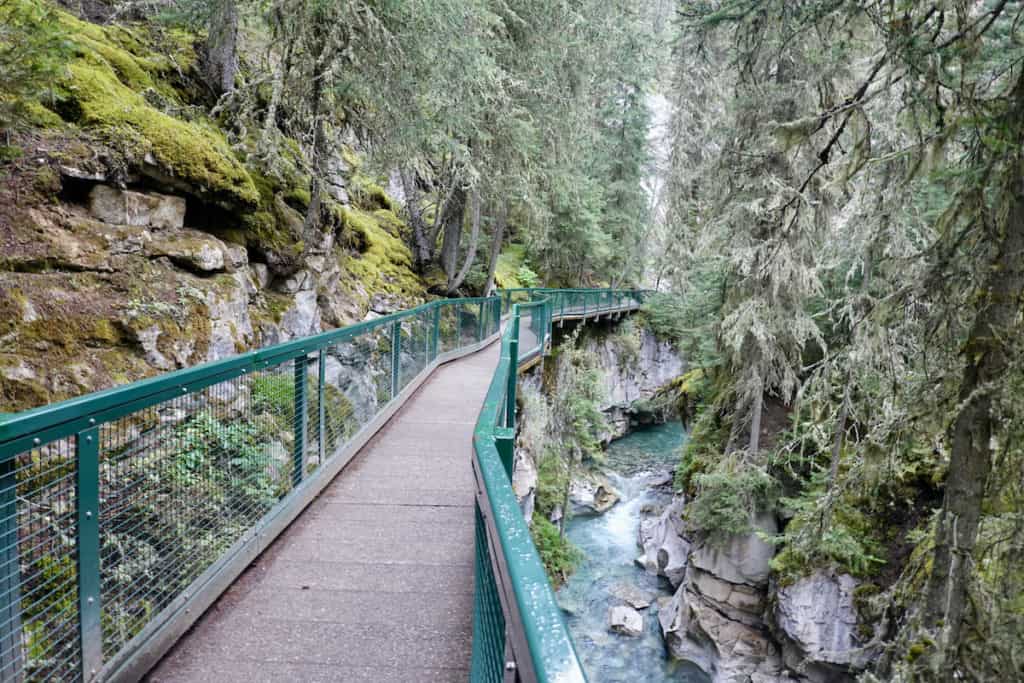
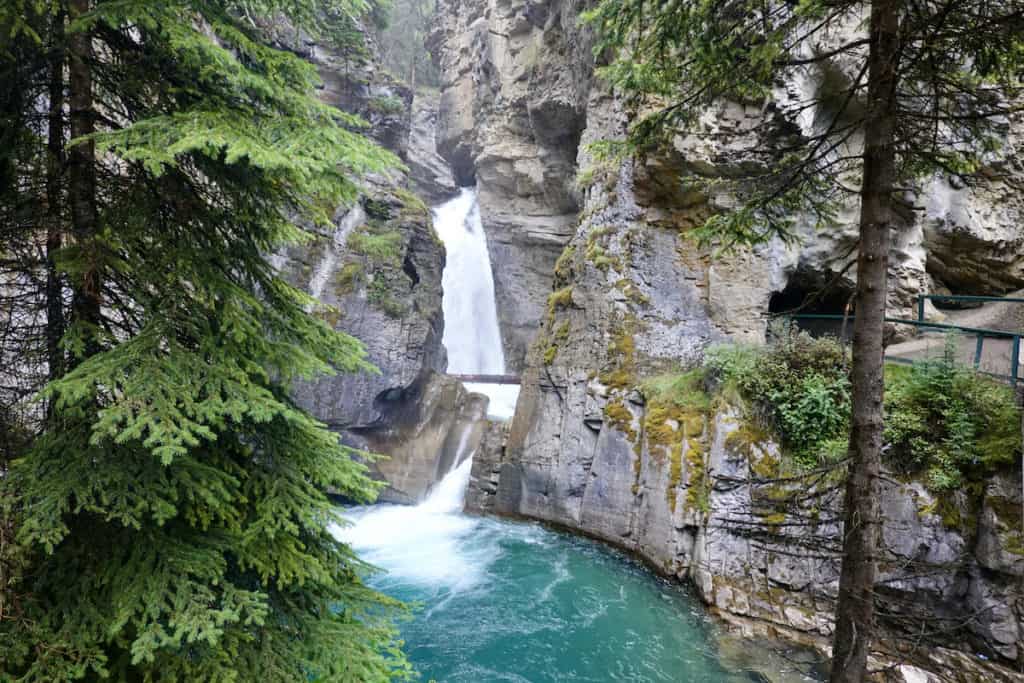
Besides the actual scenic drive along the Bow Valley Parkway (Route 1A), the highlights for us were:
- hiking in Johnston Canyon — a must-see (with an elevated catwalk along the canyon wall with beautiful scenery and impressive waterfalls);
- having a bite to eat at the cozy, charming alpine-inspired Storm Mountain Lodge;
- the Cirrus Mountain Lookout (from where you gain a perspective of the topography of the area with mountains rising on both sides of the valley); and
- Morant’s Curve (location of one of the most iconic photographs of the area).
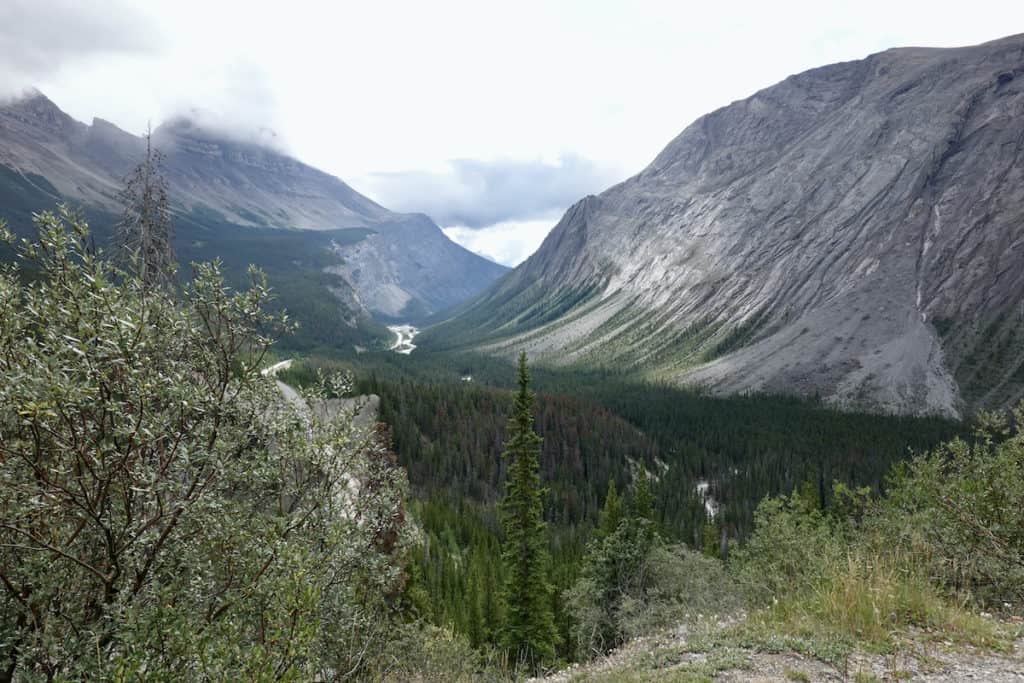
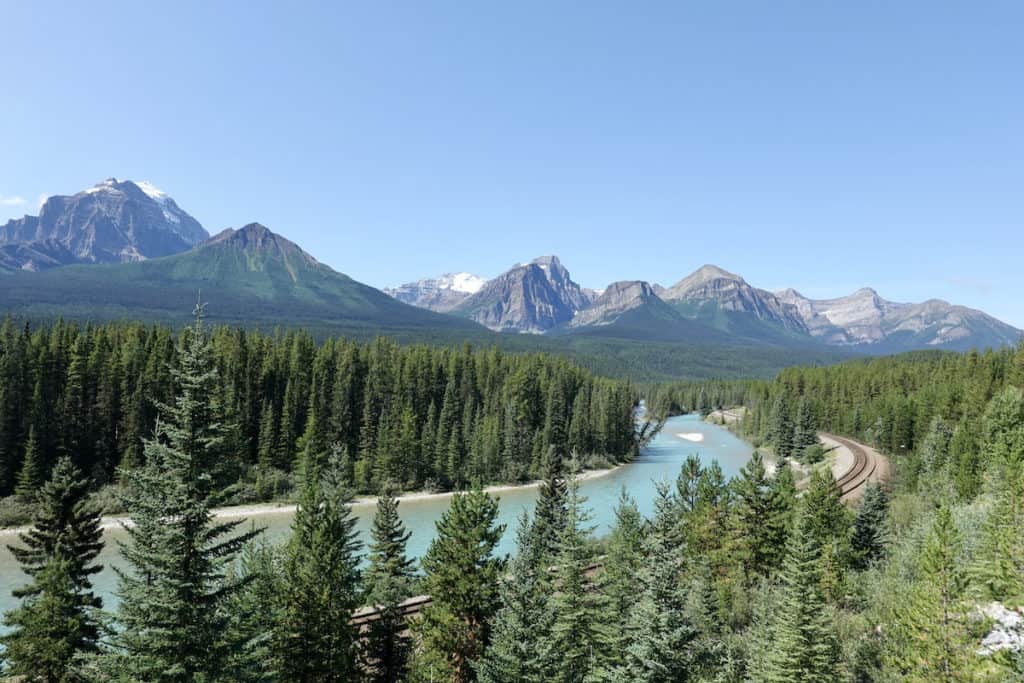
Lake Louise
Not to be confused with the town of Lake Louise, Lake Louise is about 2.5 miles/4 kilometers west of Route 1 and sits behind the legendary Fairmont Chateau Lake Louise hotel. While here you’ll revel in the beauty of the lake itself as well as Mount Victoria (over 11,000 feet/3,352 meters high). This is such a popular tourist stop that there might be plenty of cars in the parking lot and plenty of visitors by the lake vying for the perfect photograph. If you stay at the hotel (highly suggested), you’ll be able to take in the amazing views all the time and find quiet spaces to relax in comfort.
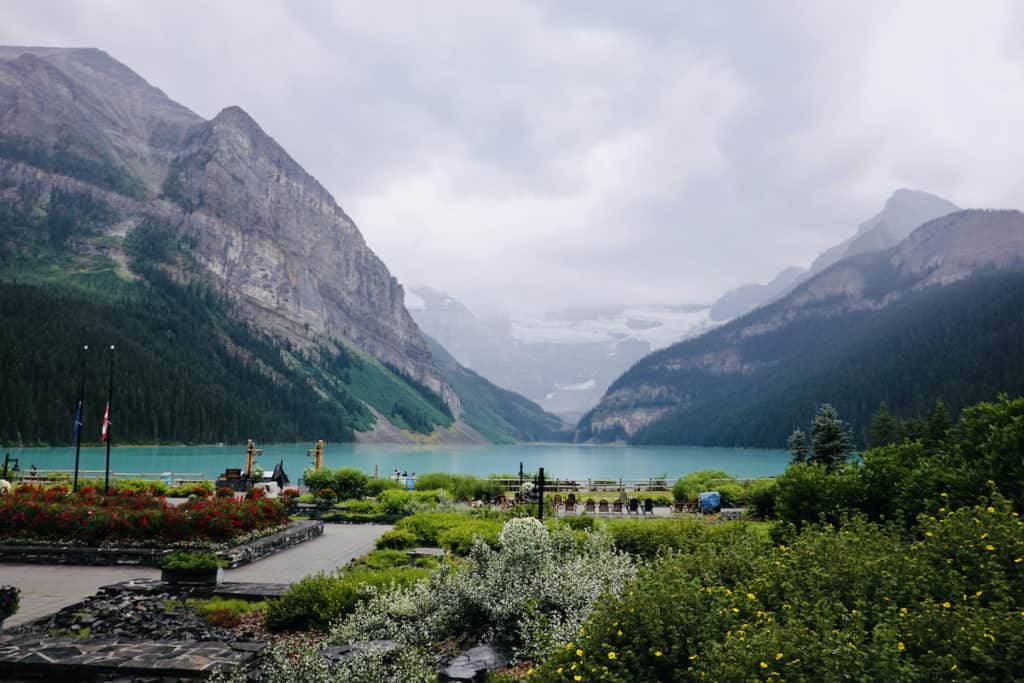
You could spend your whole visit to the Fairmont Chateau Lake Louise. It offers that many spectacular landscape vistas not to mention the spa and other attractive features. Popular recreation options here are canoeing on Lake Louise (rentals are available for hotel guests and day visitors) and hiking. Some of the most popular hikes are the:
Lake Louise Lakefront Trail
Stroll along this 2.8-mile/4.5-kilometer out-and-back path along gorgeous Lake Louise. Pick up this trail by the Chateau Lake Louise (near a parking area for public access). It’s a great way to have a leisurely walk along even terrain while surrounded by incredible natural beauty.
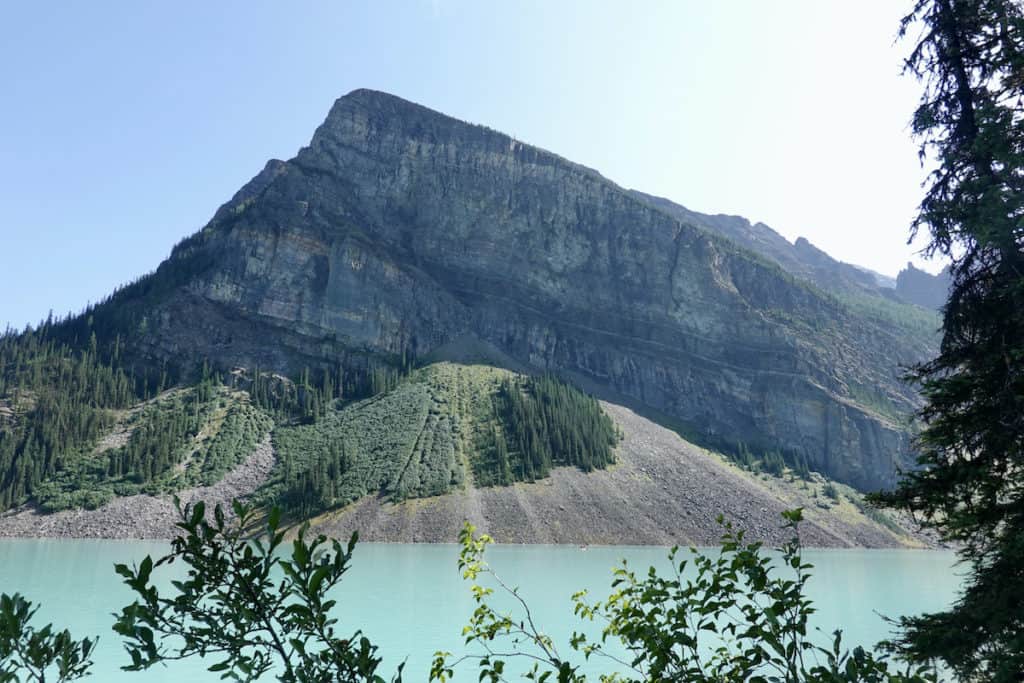
Lake Agnes Trail
Lake Agnes Trail is a 4.6-mile/7.4-kilometer out-and-back moderately-rated hike that begins at Lake Louise and continues up the side of a mountain with a switchback path and an elevation gain of 1,427 feet/435 meters. What makes this a special outing is passing Mirror Lake and later a waterfall before reaching Lake Agnes and the adjacent charming and rustic Lake Agnes Tea House at the top. This was one of the highlights of our visit to Lake Louise. If you go on this hike, leave early (before 8:00 am) for the best experience. The trail and the tea house get quite crowded later in the morning and in the afternoon.
A Unique Dining Spot
How does the tea house staff manage a dining destination on a mountain? Interestingly, this tea house is provisioned once a year at the beginning of the season by helicopter. That’s when the heavy things (propane, flour, sugar, and so on) are stocked for the summer. Seasonal staff members live by the tea house in shifts (that are several days long); they take turns hiking down the mountain to carry garbage and recycling, and then hike back up with fresh fruit and vegetables, as needed. Oh, one more thing: there’s no electricity on the mountain. One more challenge that the tea house staff handles remarkably well.
Once at the tea house, you can enjoy delicious baked goods, sandwiches, soup, and tea (of course!) before heading on another trail or returning to your starting point at the Chateau. We loved our excursion up to the Lake Agnes Tea House; and we continued on the Little Beehive trail that offered still more incredible views.
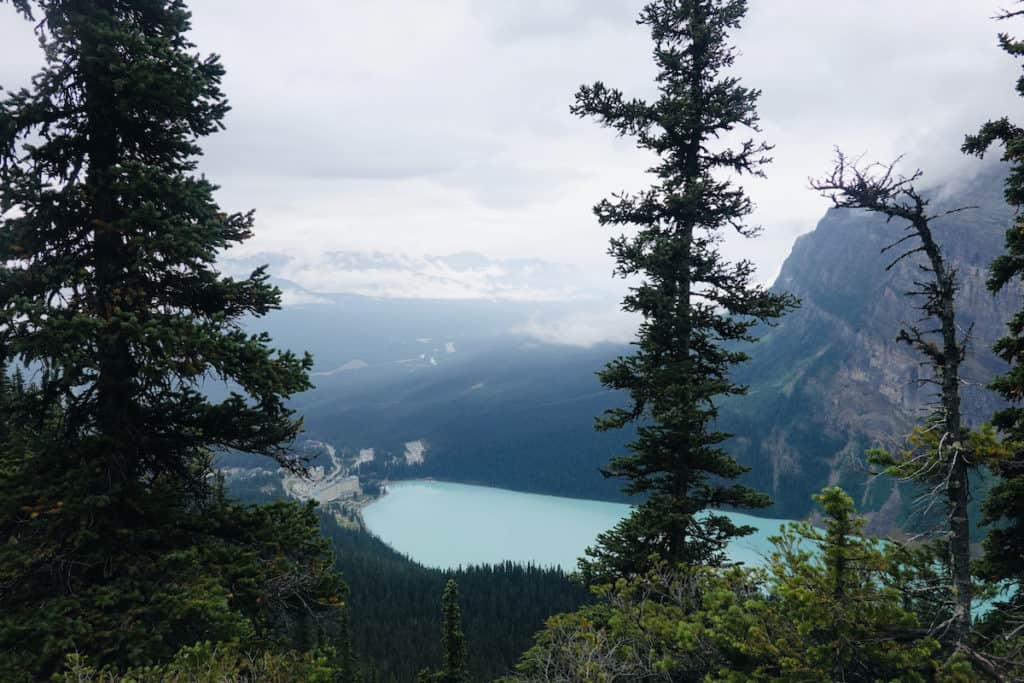
Plain of the Six Glaciers Trail
This 9.1-mile/14.6-kilometer out-and-back moderately-rated trail begins at Lake Louise, passes through a forested area, and features a tea house (a different tea house from the Lake Agnes trail). With an elevation gain of 1,929 feet/588 meters, this trail is less populated than the Lake Agnes trail because of its length, and some people prefer it because of that. If you have the time, why not?!
Moraine Lake
A very popular place, scenic Moraine Lake offers a 2-mile/3.2-kilometer path around it. You’ll need to head here very early in the morning (before 6:00 am) to have a chance at getting a parking spot; otherwise, you’ll need to take a shuttle to get to and from the lake. (We opted not to visit here due to how heavily touristed it is and how much time the whole excursion would take us via the shuttle.)
Driving from Lake Louise to Jasper
One of the most spectacular parts of this driving trip is the Icefields Parkway, taking you 145 miles/233 kilometers from Lake Louise to Jasper. It is considered by many to be one of the most scenic drives in the world.
When you set off on the Icefields Parkway from Lake Louise, you’ll view plenty of majestic mountains plus lovely lakes and waterfalls. Although it could take you 3-4 hours to drive this straight through, you don’t want to hurry this trip up. In fact, my husband and I took close to 9 hours on this drive because we stopped to take pictures at scenic lookouts and for two hikes. There’s that much natural beauty to be discovered and treasured. We also stopped for lunch at the Saskatchewan River Crossing; that was a good midway point to stretch our legs and eat a good, hearty lunch (and visit a modern bathroom with flush toilets – yay!). You can top off your gas tank here, too, if you need to.
The highlights of this drive for me were the:
Mistaya Canyon
Mistaya Canyon has been shaped by the thundering water that rushes through it. Reaching the canyon is a short walk from the parking lot and well worth some time. We spent close to an hour here, mesmerized by the rushing water and viewing its impact on the rocky canyon walls. The canyon is about 46 miles/74 kilometers from Lake Louise.
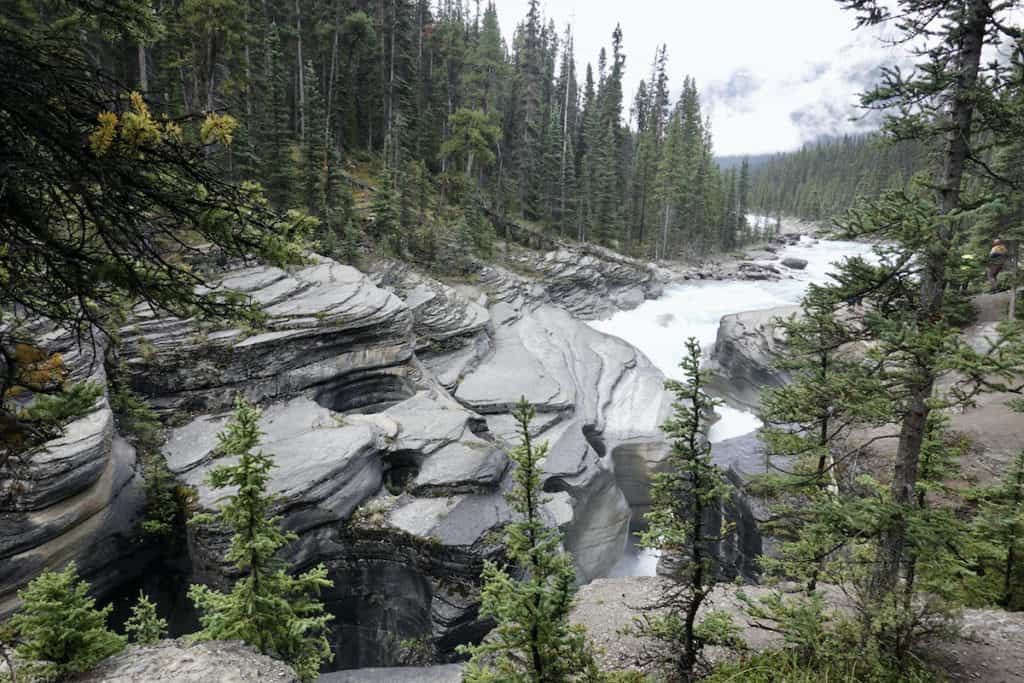
Parker Ridge Hike
This 3.2-mile/5.1-kilometer out-and-back moderately-rated hike up Parker Ridge results in amazing payoffs at the top: the Saskatchewan Glacier below on the other side of the mountain. This hike has an elevation gain of 882 feet/269 meters. Walking along the ridge, you’ll be tempted to linger awhile. We did, and we have no regrets. Parker Ridge is about 75 miles/120 kilometers from Lake Louise.
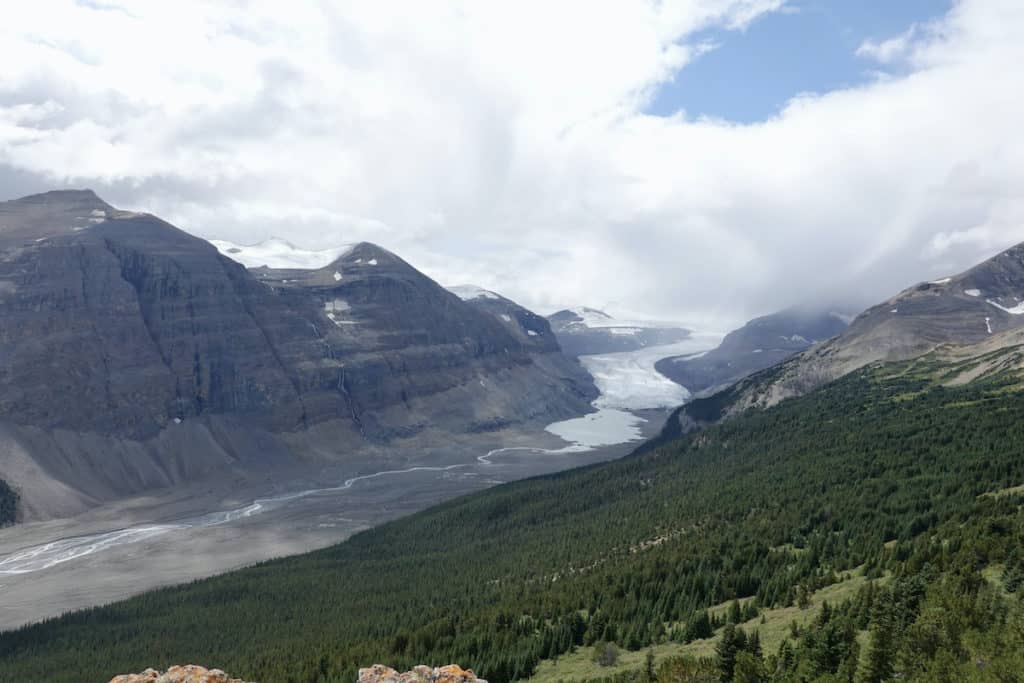
Columbia Icefields
The largest icefield south of the Arctic Circle, this is a very popular tourist destination with excursions (on foot or by vehicle) onto the icefield as well as a shuttle to a nearby Skywalk that offers more impressive views. The Columbia Icefields is about 78 miles/125 kilometers from Lake Louise.
Waterfalls!
Three waterfalls that are each worth a stop are Tangle Falls, Sunwapta Falls, and Athabasca Falls (all close to Jasper).
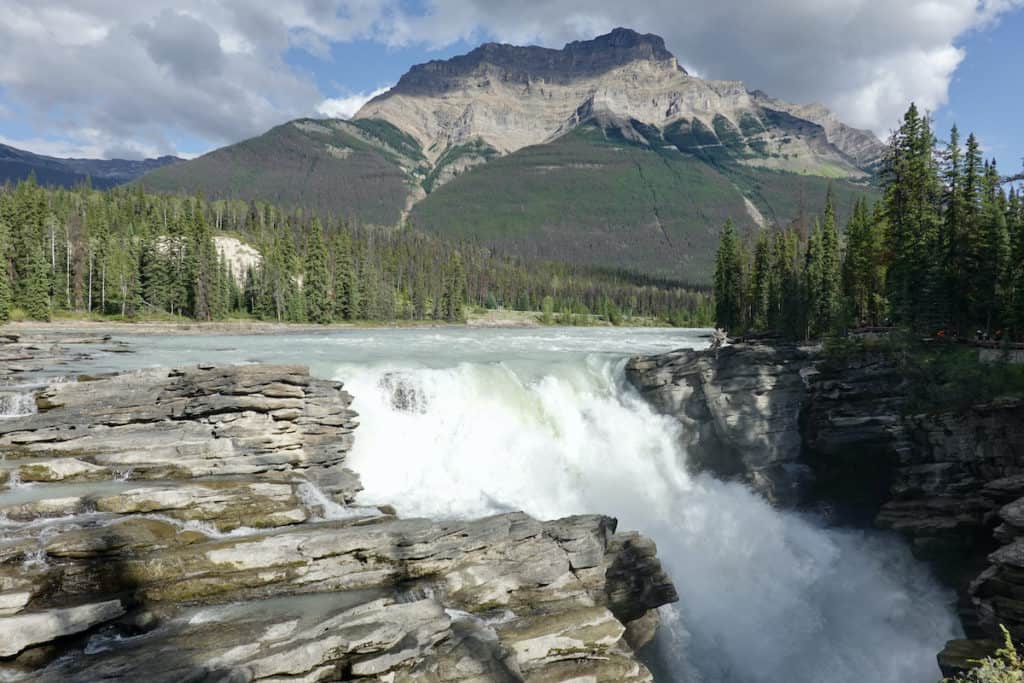
Jasper
Founded in 1813, Jasper is the commercial center of Jasper National Park. The main attractions are the incredible mountains, rivers, and wildlife. The town itself is charming with inviting restaurants and shops. Popular Jasper tourist treats are the Jasper Sky Tram (taking you 3,200 feet/975 meters up along the face of a mountain), Mount Edith Cavell (for hiking with great vistas), Miette Hot Springs, Maligne Canyon, Maligne Lake as well as Patricia Lake and Pyramid Lake.
People are drawn to the magnificent beauty of the Canadian Rockies, and hiking is the ideal way to experience the nature that abounds. There are plenty of hiking options around Jasper. Some are at the stops along the Icefield Parkway south of the town itself as well as at the spots already listed like Maligne Canyon and Mount Edith Cavell.
My favorite hike in Jasper was at:
Maligne Canyon
Hike along the Maligne River as it rushes through the Maligne Canyon. There are several footbridges that cross the water and spectacular views all along the waterside trail. This hike offered endless beautiful views and refreshing sounds of water rushing through the canyon. The trail is tamer (and paved) by the main parking lot and the first two bridges. It transitions to a packed earth and rocky path as you progress. Although there are six footbridges you could visit in all, you can go as far as you want and turn around.
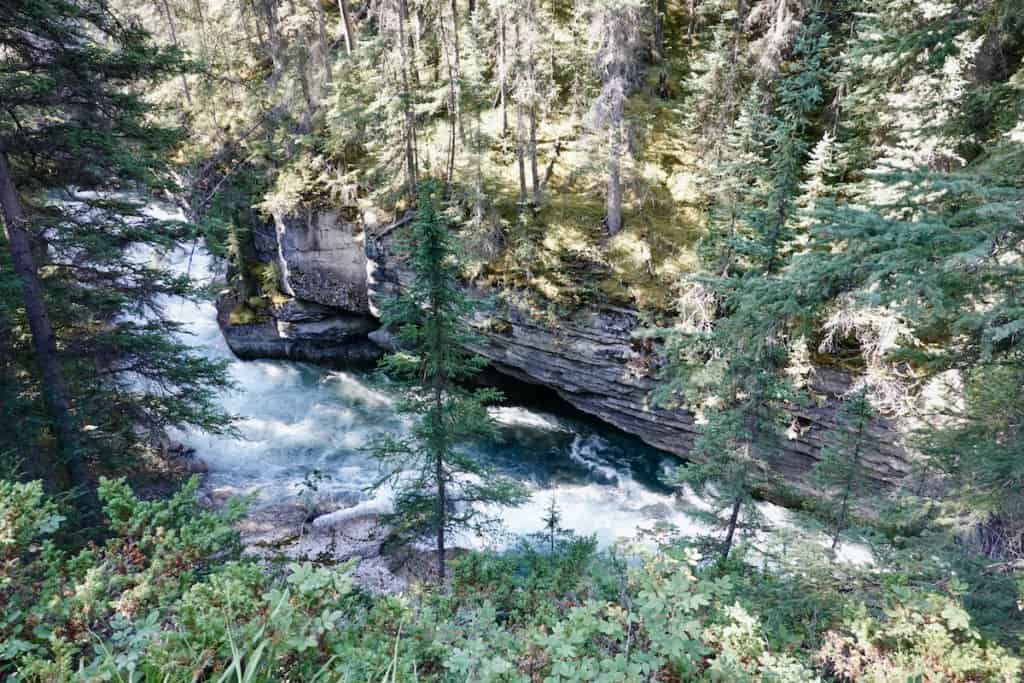
We opted to begin at Fifth Bridge and parked our rental car there. When we arrived around 9:00 am, there were only two other cars in the lot. Most people arrive and park at the main parking lot near First Bridge, but we prefer hiking in less congested areas. Coming from this direction, we saw the Maligne River approaching us (to the right of the trail) which became smaller as we approached the First Bridge. Once we got to the First Bridge (near the main parking lot which was full), we went into the modern tea house and gift shop before heading back down the trail to the Fifth Bridge. Bring along hiking poles, if you use them, and water.
At the end of our stay in Jasper, we returned our rental car and got ready for our next two days aboard the Rocky Mountaineer, a luxury passenger train. All aboard!
Rocky Mountaineer Train Ride from Jasper to Vancouver
Rocky Mountaineer is a train ride you’ll surely enjoy at the time and remember fondly after you return home. The train has several route options, and we chose the two-day westward option that ferried us from Jasper to Vancouver — from the western portion of Alberta all the way through British Columbia — with an overnight stop in a Kamloops hotel. The train carries passengers during the days; guests overnight in hotels that are booked by Rocky Mountaineer.
We enjoyed the perks of traveling in Gold Leaf service. The Gold Leaf two-level cars offer expansive panoramic window views on the second level where the seats are and a dining room with large plate glass windows on the first level. Plus there’s an outdoor vestibule that’s a good perch for taking pictures of the landscape.
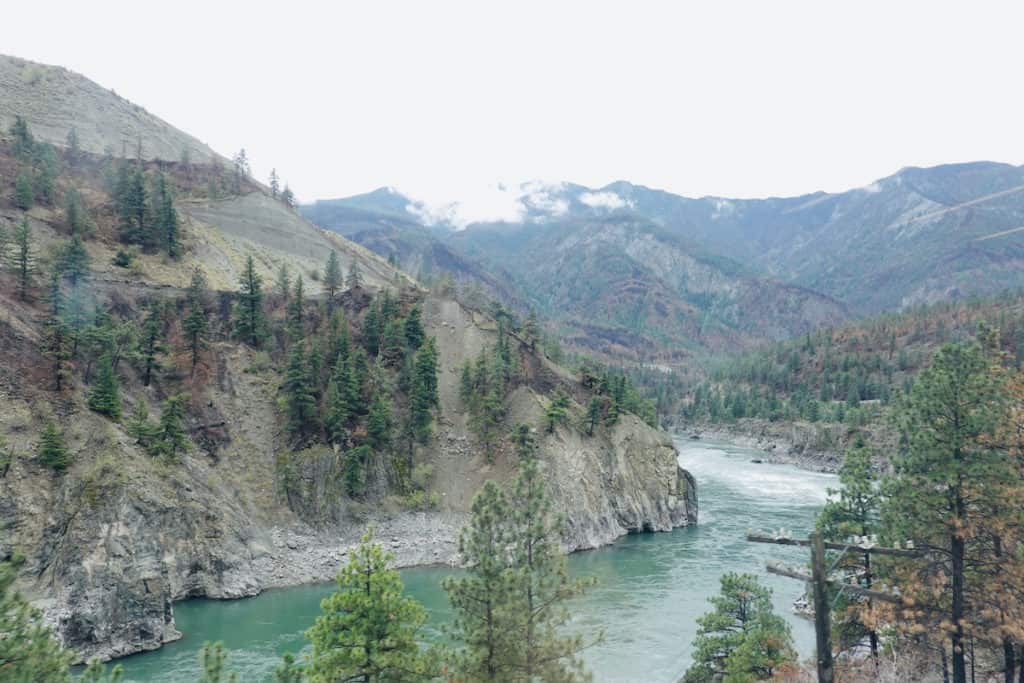
When aboard the train, you’ll pass by beautiful wilderness scenery with some narration provided by the host in your train car. You’ll be alerted to wildlife outside the windows. Sometimes it’s hard for an untrained eye to notice big horn sheep, for example, but your host will tell you where to look.
Besides that, you’ll relax in the very comfortable train cars and be served delicious food and beverages during the day. (Wear comfy clothes — your waistband may need to expand on this leg of your trip!) Seriously, you’ll feel like royalty aboard the train. There’s a full complimentary beverage (non-alcoholic and alcoholic) and snack service at your seat — this is in addition to breakfast and lunch. We enjoyed lingering over the gourmet breakfasts and lunches while getting to know some fellow travelers.
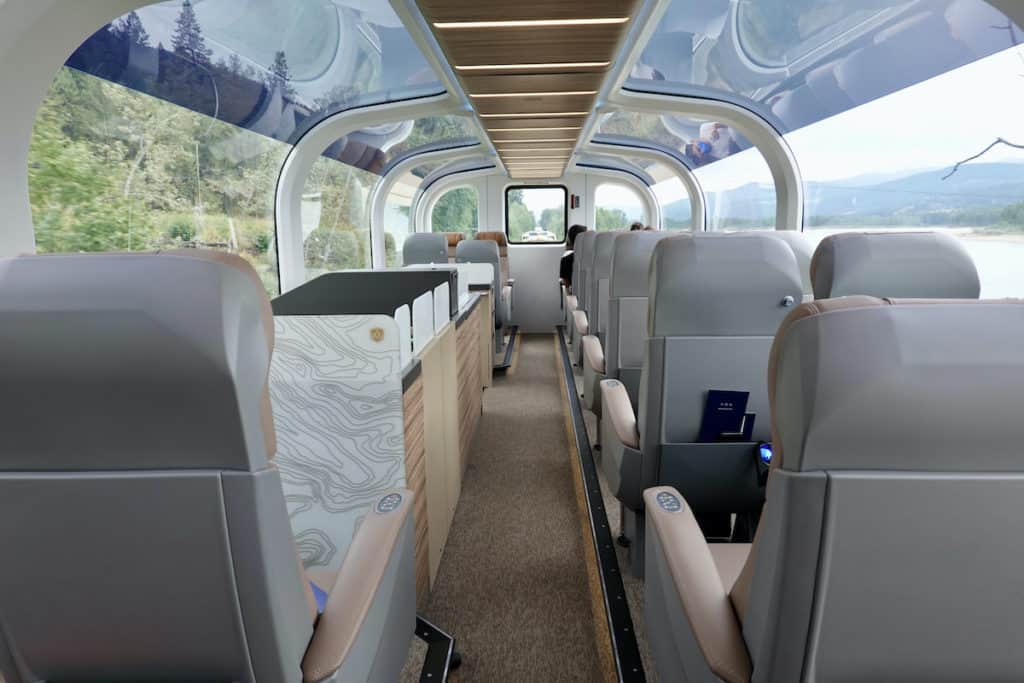
Vancouver
Vancouver is a wonderful city to explore. We spent three full days in the area, using the city as a home base. A west coast seaport, Vancouver has a population of about 2.7 million people and is the third-largest metropolitan area in Canada (after Toronto and Montreal). Its climate is temperate, and it gets a bit of rain from fall to spring.
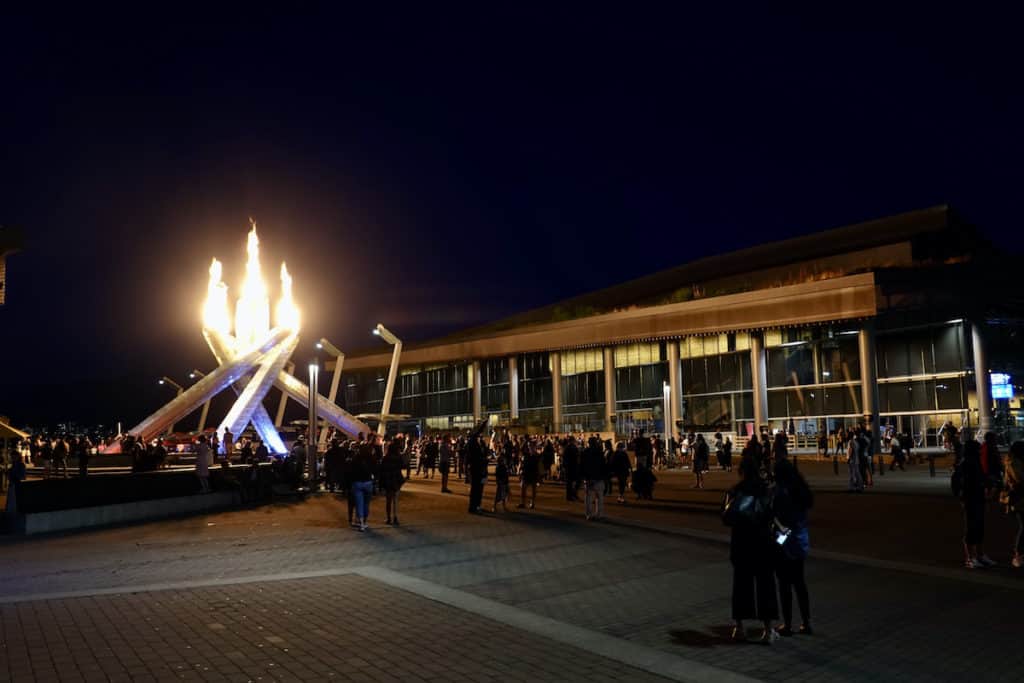
My husband and I stayed in a hotel near the waterfront (more on it later) and spent most of our time in that area. We found the entire region to be very friendly to pedestrians and bicyclists alike. In fact, there are bike rental shops in the area (especially as you get close to Stanley Park), and that’s a fun way to explore the city.
The high points of our stay in Vancouver were:
Granville Island Public Market
This indoor market (with some outdoor spaces) boasts a wide variety of locally raised and produced food, art galleries, and boutique shops. We enjoyed moseying around and looking at the delectable baked goods, produce, meats, and seafood. When our stomachs started talking to us, we each found exactly what we wanted for lunch (my husband chose Korean BBQ and I opted for Thai Panang Curry — each at different vendors) and then we sat at a table to dig into our feasts. After that, we ventured outside to the boutiques, bought a treasure to remind us of the trip, and then stopped for a beer at the Granville Island Brewery. We leisurely sipped our beers while watching people stroll by.
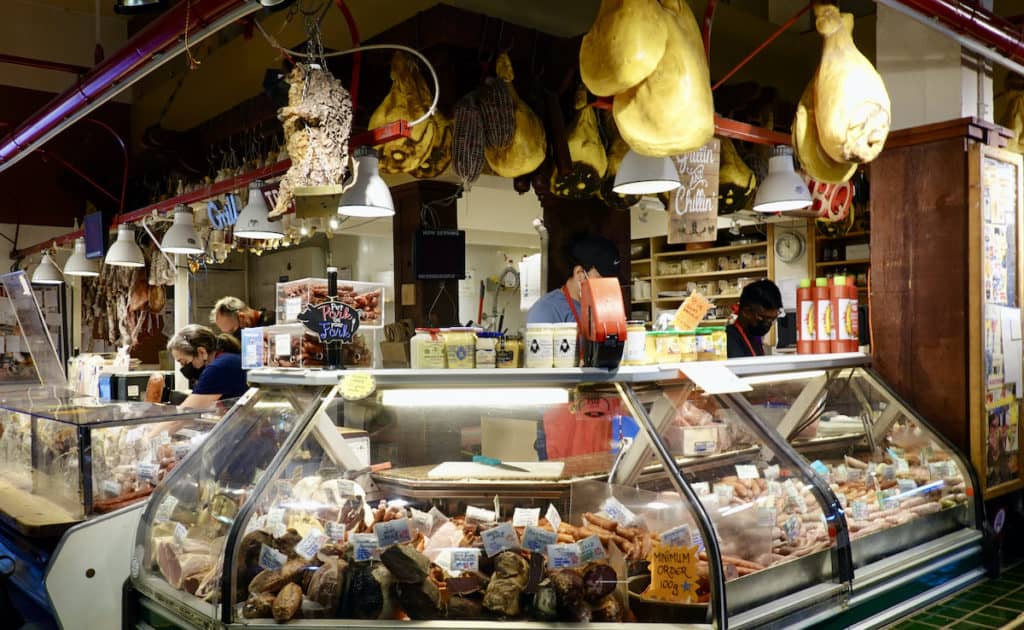
Besides the market itself, what helped make this a memorable outing was how we got there. We took the Skytrain (that started near our hotel as a subway and then climbed outside and became an elevated train) to the Science World station. We walked across the street and boarded a water taxi (we used Aquabus) that operates in False Creek which, after a few stops, landed us at the Granville Island Public Market. The water taxi was fun because each of the captains was jovial and conversational, so we learned a bit more about the area from them. They gave us some tips to help us enjoy the public market and general area, too.
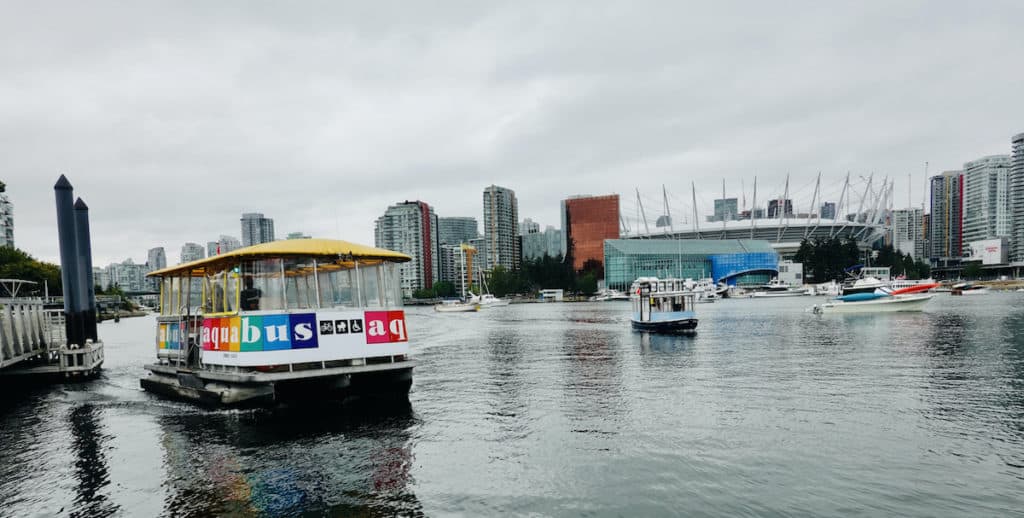
Stanley Park
With over 1,000 acres (larger than New York’s Central Park), Stanley Park is on a peninsula along the Vancouver waterfront. It has plenty of trails for walking or bicycling; in fact, the seawall path has two lanes: one for foot traffic, the other for bikes. Stanley Park is mostly forested with some beautiful gardens, a lighthouse, a children’s play area, an aquarium, concession stands, a dining spot, and even horse-drawn carriage rides. It’s easy to spend a few hours here strolling or biking while enjoying the water views, viewing seaplanes take off and land on the water, sitting on a bench while people-watching, or simply meandering one of the interior trails and admiring the gorgeous trees, shrubs, and flowers.
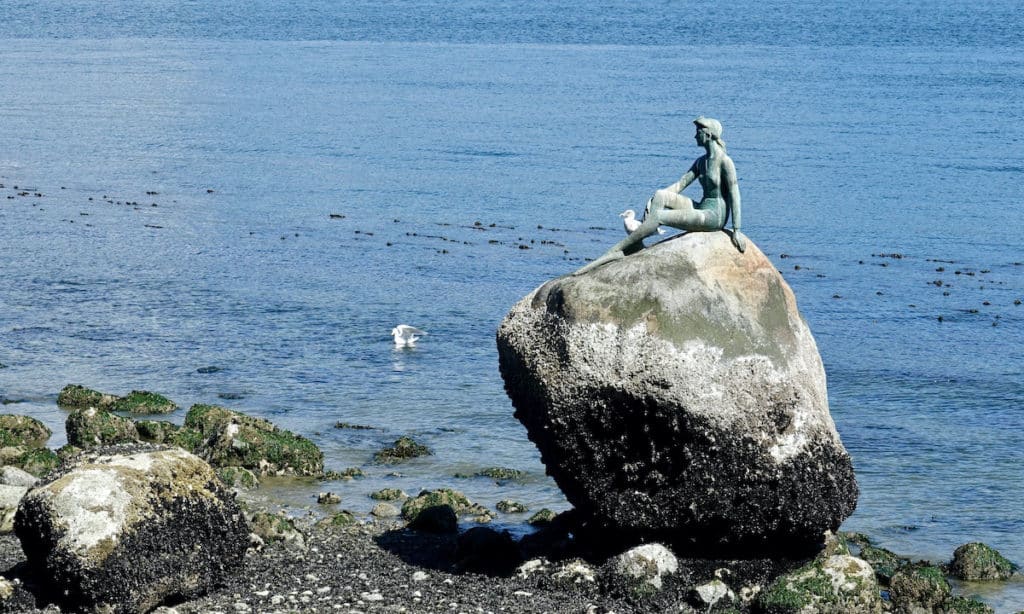
Victoria
Located at the southern tip of Vancouver Island, Victoria is the capital of British Columbia, a Canadian province. Granted, it’s confusing to some. The city of Vancouver is on the mainland — not on Vancouver Island. From Vancouver, reach Victoria by ferry (about a 90-minute ride) or by seaplane (about a 35-minute flight). We chose to make a day trip to Victoria — a great idea when staying in Vancouver.
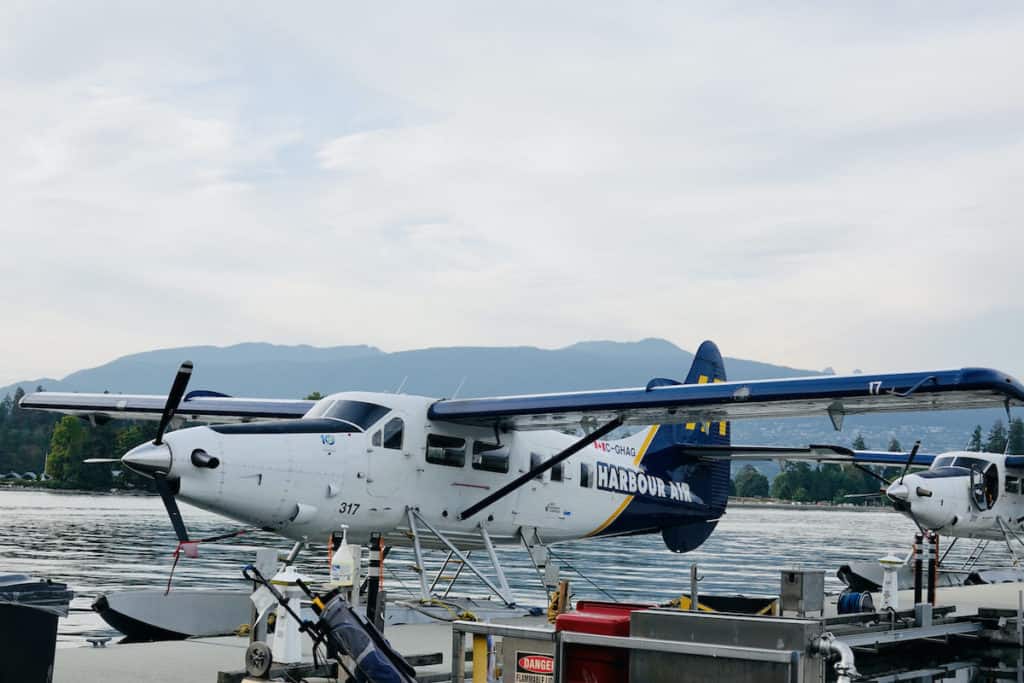
Originally, we had planned to take the ferry from Vancouver to Victoria, but then we learned it would be at least a 45-minute taxi ride from our hotel to the ferry terminal — making a one-way trip to Victoria over two hours long. So we opted for the seaplane, and it was a good decision for us. I’m a somewhat nervous flyer, but I was impressed with the smooth takeoffs, rides, and landings of our seaplane experience. (I’m a convert now.) In a day, you could easily take in Victoria’s highlights — and maybe even opt for high tea at the impressive, historical Empress Hotel that sits right in front of Victoria’s harbor.
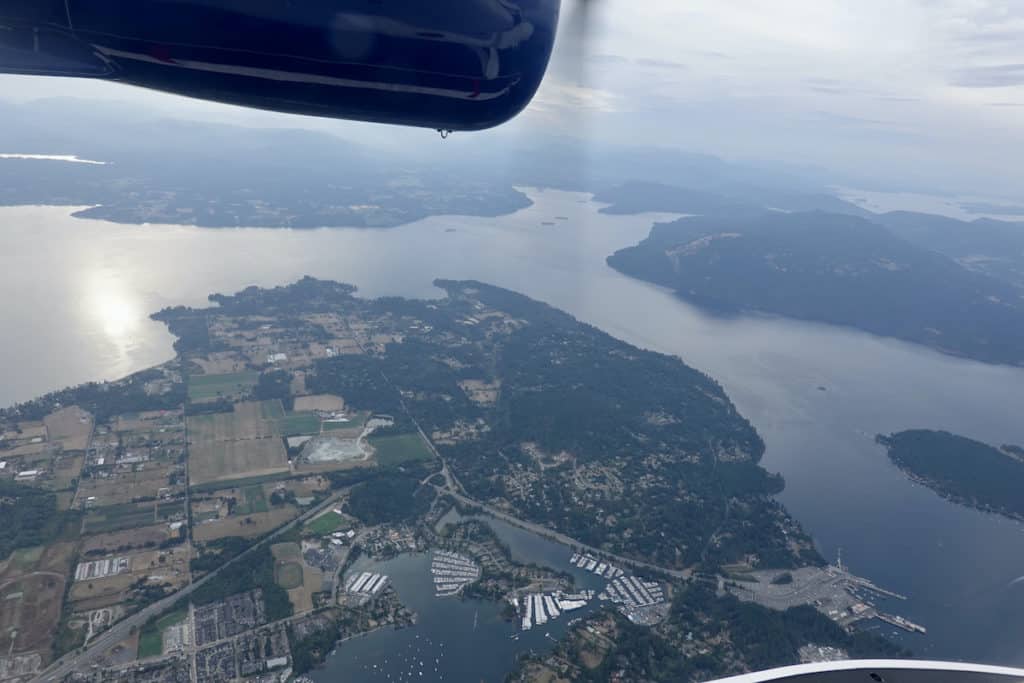
What I enjoyed most about our visit to Victoria was:
Butchart Gardens
Located 20 minutes north of downtown Victoria, Butchart Gardens is a 55-acre garden and national historic area. Created in 1904, it boasts amazing displays of plants, of course, and they are worth taking the time to admire. In addition, there’s a carousel, an impressive 70-foot/21-meter tall undulating fountain, a Japanese garden, and an Italian garden (with a gelato stand). Stroll through the gardens to become inspired for your own home garden or just to enjoy all the beautiful settings in this place. The large gift shop houses lots of tempting home and garden items.
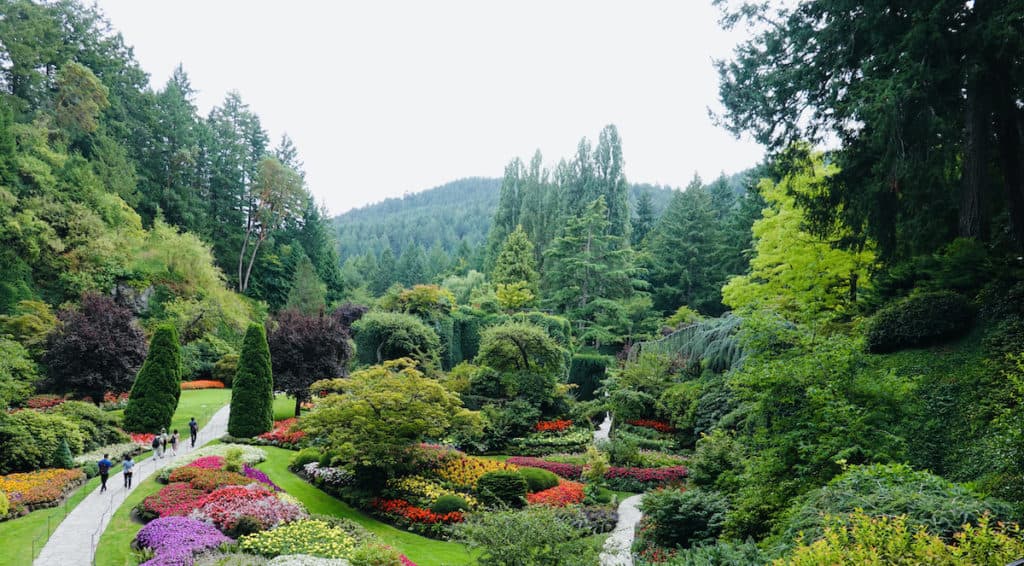
Fisherman’s Wharf
Walk about 20 minutes from downtown to reach the wharf. Colorful houseboats draw your eye as you approach the area. There are several booths or huts that sell food, fresh seafood, and tickets for whale-watching and kayak tours. Fisherman’s Wharf exudes a funky, energetic vibe that’s fun to experience.
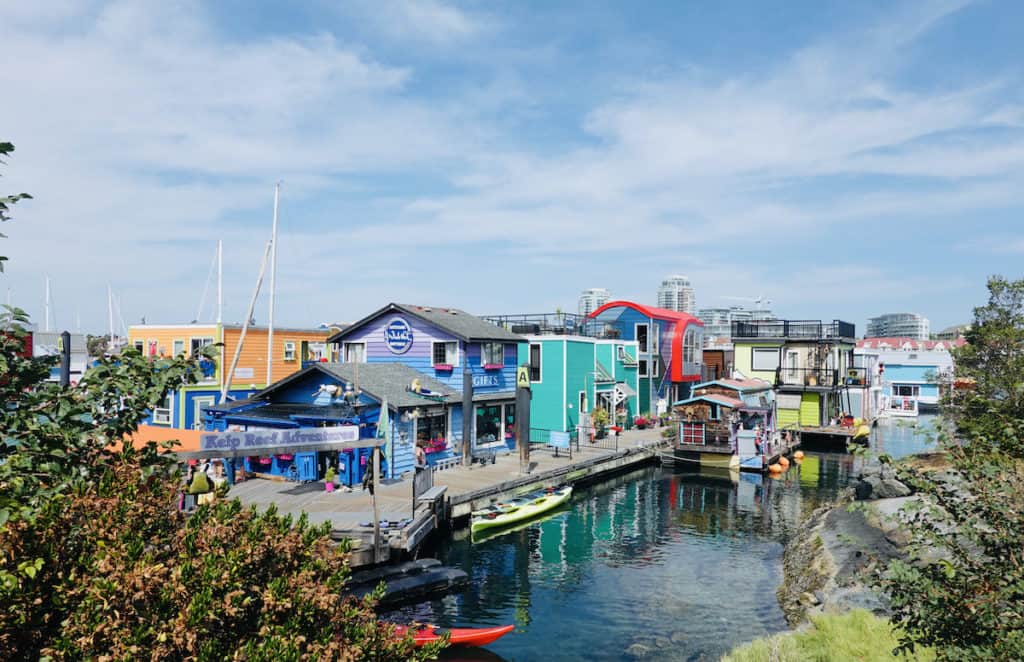
Walking through Downtown Victoria
Stroll through the downtown and you’ll come across lovely shops, pubs that are housed in once-stately old banks, restaurants, and a public market featuring locally grown and prepared food.
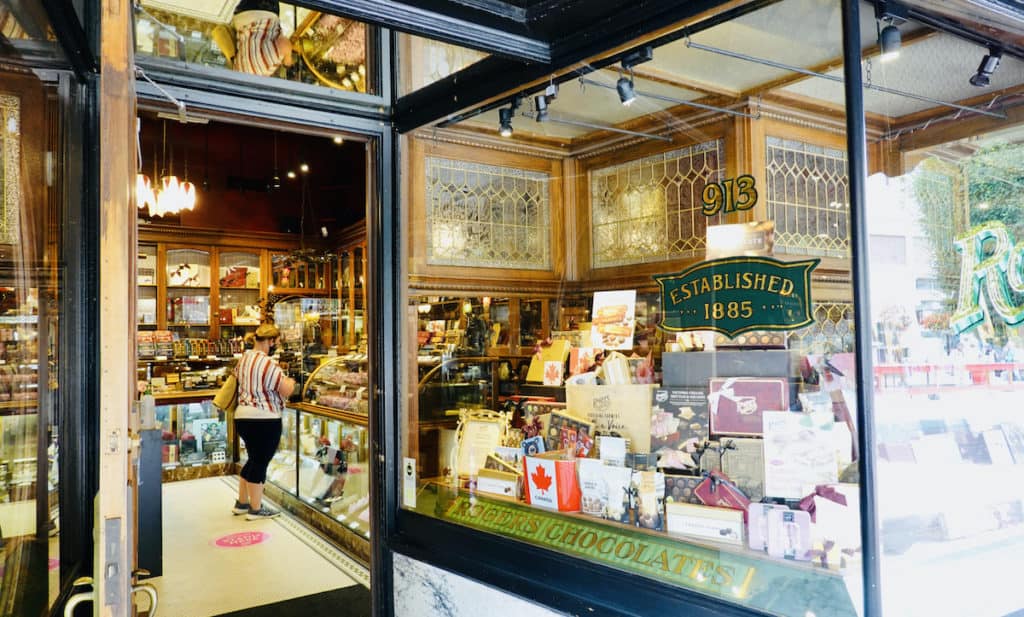
Canadian Rockies Planning Tips
- If choosing to rent a car and drive through the Canadian Rockies, begin to plan your destinations and stops along the way well before you leave home — up to several months before your departure.
- Purchase a Banff National Park pass, so you’re all set before you you leave home.
- If driving on your own through the Rockies, consider using the GyPSy audio tours that work on GPS and are not dependent on cell service or wifi. You purchase the GyPSy tours for the areas you’ll be visiting. (I bought the Canadian Rockies audio tour.) Buy and download them before your trip so you’re all set to go once you reach your destination. Turn it on in your car, and you’ll have interesting commentary as you pass along certain points or landmarks. For example, in our drives from Banff to Lake Louise to Jasper (spread over several days), our GyPSy commentator explained the geological forces that created the Canadian Rockies and suggested some stops along the way. After completing our drives and talking with other travelers (who didn’t know about GyPSy), we realized how much richer our journey was because of the information provided on the sights on the drive.
- Download the free AllTrails app to help you find the perfect hiking trails for you. (There’s a paid option of the app with extra features.)
- Keep your devices juiced up on the road. Since you’ll be driving a bit (and maybe using the GyPSy audio tour), consider buying a charger with two USB ports (for you and your traveling buddy) that fits into the cavity originally designed for a cigarette lighter.
- Once at your hotel, stop to chat with the concierge to gain some insights into great local recreation opportunities, restaurants, and shops. The concierge will often make meal reservations for you, too.
- If needing to obtain local currency (Canadian dollar) before you leave town, try to get a mix of denominations, so that you will have small bills to use for tipping or small purchases. If you don’t get local currency before you leave, you can always get cash at ATMs once you arrive.
- Pack clothing layers as temperatures change with the time of year, time of day/evening, and altitude. Weather changes are especially noticeable if you’re hiking as it can be drizzling and chilly at the beginning of your hike, but then it can be dry and warmer once you get further along.
- If hiking, wear comfortable shoes with good tread (or hiking boots) and consider using trekking poles to keep you steady on the often hilly, rocky terrain.
- Expect spotty cell service — or none at all — as you journey through the Rockies.
- Bring along extra memory cards for your cameras, external batteries, and all the charging cables you’ll need for various devices. In addition, you may want to purchase a portable docking station so you can charge multiple devices (phones, tablets, cameras, watches, etc) at one time in your hotel room.
- Pack binoculars (if you have room!) to help you catch sight of wildlife you encounter along the way.
- Check out other travel tips and useful travel apps.
Measurement & Time Zone Differences
For those of you who live below the 49th parallel (the Canadian/American border) or elsewhere, remember that Canada uses the metric system. This means you’ll be hearing, reading and speaking about meters, kilometers, degrees Celsius, and so on. This took me a little getting used to. I knew kilometers were shorter than miles so I could roughly estimate mileage from kilometers, but I had a hard time mentally translating temperatures in Celsius to Fahrenheit. (For example, when getting dressed for the day in Banff, it was 6 degrees Celsius. Hmmm, that piece of information didn’t help my brain that was stuck thinking in terms of Fahrenheit.) Here’s an easy way to (approximately) convert Celsius into Fahrenheit: Celsius degrees x 2 + 30 = Fahrenheit. Thus, 10 degrees Celsius is approximately 50 degrees Fahrenheit. There you go. You’re all set!
Destinations in this trip involve two different time zones. The places in Alberta (Calgary, Banff, Lake Louise, and Jasper) are in the Mountain Time Zone. The British Columbia destinations (Kamloops, Vancouver, and Victoria) are in the Pacific Time Zone.
Where to Stay & Eat in the Canadian Rockies
The Fairmont hotels are considered destinations in themselves, so expect luxurious accommodations and amenities along with several recreation and dining options. When we traveled, Rocky Mountaineer booked Gold Leaf guests at Fairmont properties. We were so glad they did!
We knew that some of the Fairmont hotels are unique in that they were originally created to provide comfortable lodging to guests traveling on the Canadian Pacific Railway (like the Fairmont Banff Springs and the Fairmont Chateau Lake Louise), and we knew each would provide a unique experience not easily found in other hotels. These are the Fairmont properties we stayed in on our trip:
Banff: Fairmont Banff Springs
Located in Banff National Park and just a short walk from downtown Banff, the Fairmont Banff Springs is a year-round luxury hotel with a championship golf course, a spa, several inviting dining venues, and enticing shops. Built with impressive limestone rock, massive wooden staircases, and other features, this hotel’s architectural features boast Scottish influences. We especially enjoyed having some wine and munchies at the hotel’s casual (huge lounge with sofas and upholstered chairs) Rundle Bar and a wonderful dinner in the Vermillion Room.
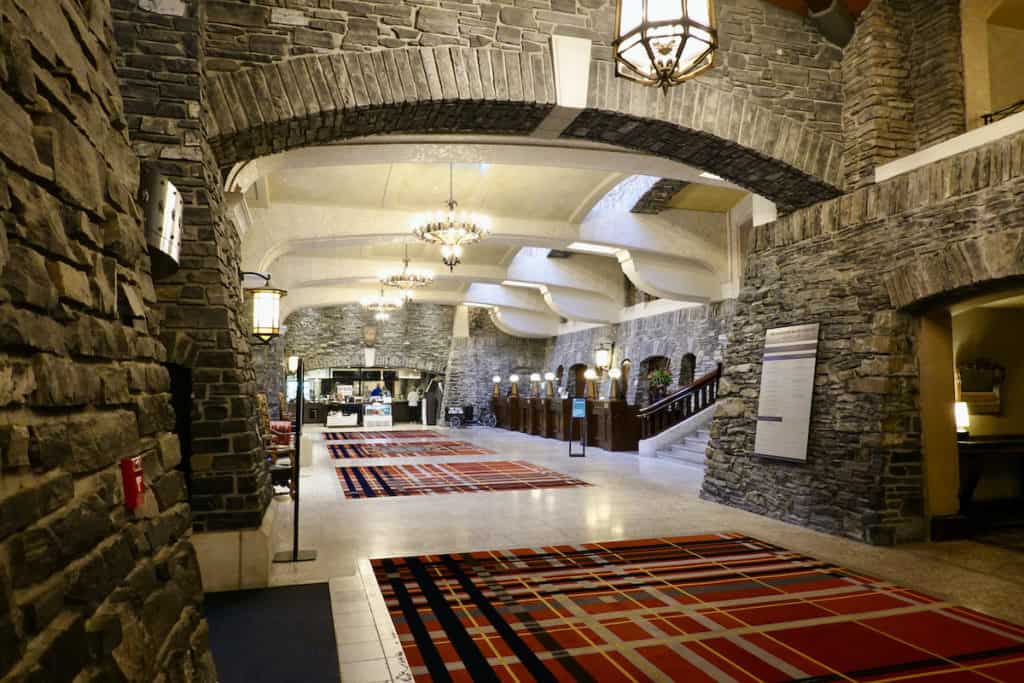
Lake Louise: Fairmont Chateau Lake Louise
You can’t get closer to Lake Louise than this property as it sits on the bank of the lake and is where you’ll find the trailheads for the popular Lake Agnes Trail and the Plain of the Six Glaciers Trail. Located in Banff National Park, the Fairmont Chateau Lake Louise offers activities on and around the lake including canoeing, hiking, and horseback riding. In addition, there’s a spa, an indoor pool, and a health club.
It started as a small lakeside cabin in the 1890s with Swiss and Austrian mountain guides available to take lodgers on hikes in this mountainous area. A lot has changed since then. Today the Fairmont Chateau Lake Louise is a world-renowned hotel with over 500 guest rooms, and guests can enjoy elegant comfort while admiring its breathtaking views of Lake Louise and mountain landscapes.
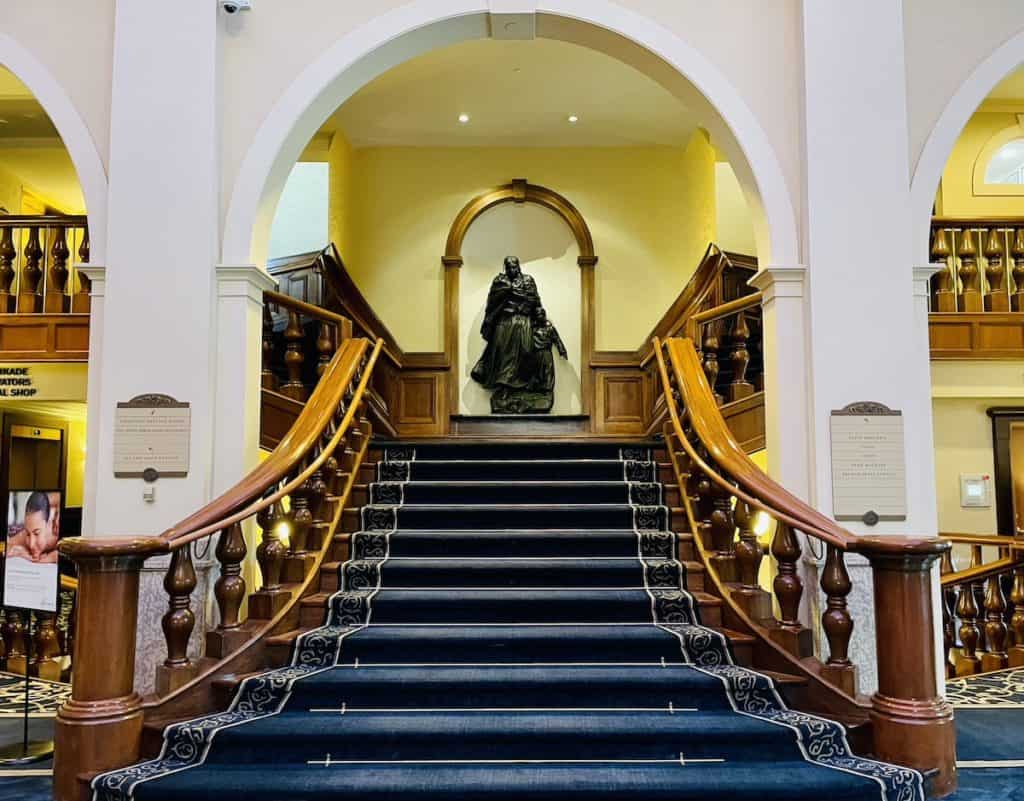
The location can’t be beaten because there are amazing views of Lake Louise and its surrounding mountains from most rooms. And those views didn’t fade away while we were dining in the hotel’s Lakeview Lounge or Fairview Restaurant. This is definitely the place to stay at Lake Louise.
Jasper: Fairmont Jasper Park Lodge
Located in Jasper National Park and just outside the town of Jasper, the Fairmont Jasper Park Lodge opened in 1921 and is a sprawling 700-acre luxury mountain resort on the shores of Lac Beauvert (translated from French as “Beautiful Green Lake”). The resort features a golf course, a picturesque lake with rentals for some fun on the water (canoes, kayaks, pedal boats, stand-up paddle boards), an outdoor pool, restaurants, a spa, an art gallery, and shops. While here, we enjoyed lunch at Harvest Food & Drink (in town) and other meals onsite at the Fairmont Jasper Park Lodge.
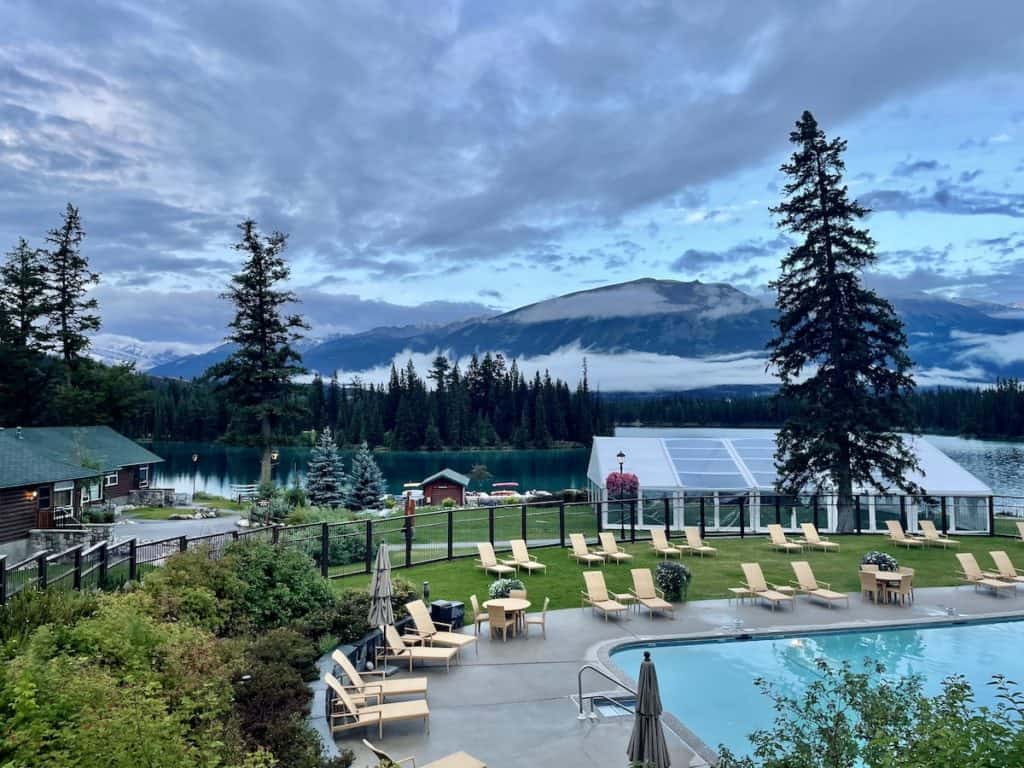
Vancouver: Fairmont Waterfront Hotel
Overlooking Vancouver Harbor, the Fairmont Waterfront Hotel boasts a rooftop pool and garden, a spa, and a health club. Its location is perfect for tourists as it’s close to the convention center and has plenty of great restaurants. Stanley Park is just over a mile away and it’s a nice walk along the harbor to the park. Seaplane service is handy on the waterfront, too, if you want to get to Victoria in just over 30 minutes — or to go on a sightseeing tour by air. The SkyTrain (subway/elevated train) station is across the street, and that can take you all over the city quickly. We rode the SkyTrain (and then took a water taxi) to Granville Island to enjoy some time at the Granville Island Public Market which had plenty of food/dining choices and other shops.
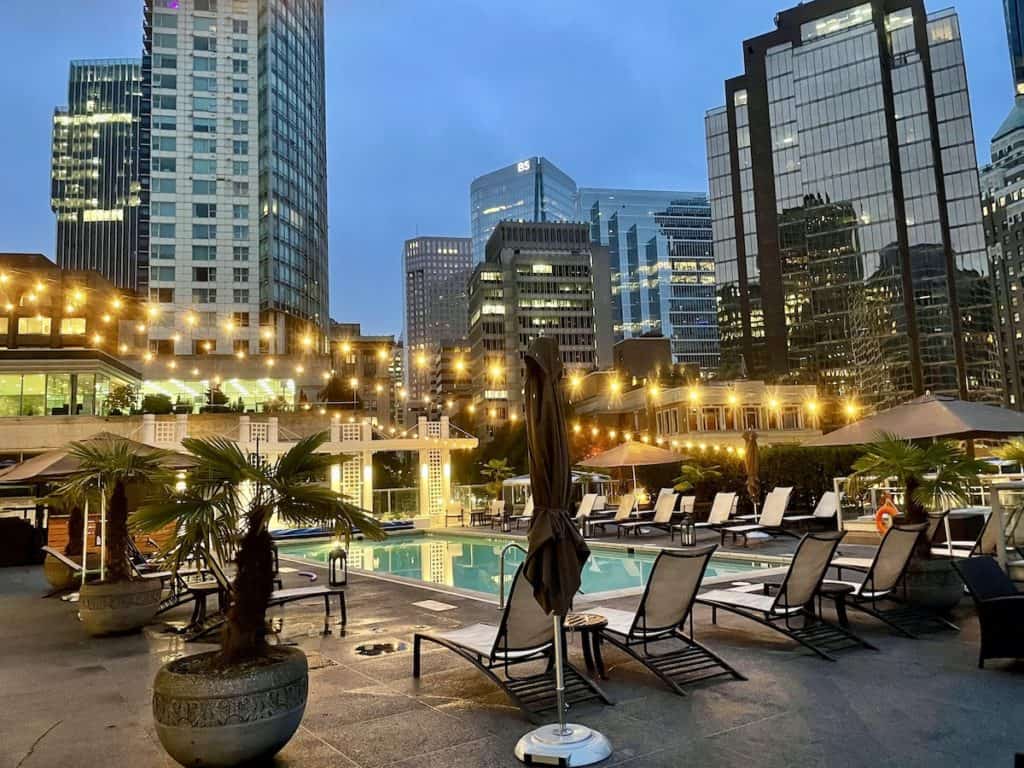
Vancouver has no shortage of excellent restaurants. We ate some very good meals in the hotel restaurant and also thoroughly enjoyed our dinners at Joe Fortes (amazing food in a lively, yet cozy, atmosphere) and Cardero’s (excellent food on the waterfront with indoor and outdoor dining).
Related Articles: Canada
- Alberta: Jasper’s Maligne Canyon: Amazing HIkes & Vistas
- Alberta: Johnston Canyon, A Unique & Scenic Canyon Hike in Banff National Park
- Alberta: Lake Agnes, A Unique Hike & Treat in Lake Louise
- Alberta: Parker Ridge Trail, A Great Hike with a Glacial View in the Canadian Rockies
- Alberta: Wonderful Walks & Hikes in the Canadian Rockies
- Nova Scotia: Balancing Rock, A Unique Rock Formation in Nova Scotia
- Nova Scotia: Best Ways to Experience the Phenomenal Bay of Fundy
- Nova Scotia: Five Fabulous Wineries in Nova Scotia
- Nova Scotia: Halifax: Top Sights to See in Nova Scotia’s Capital
- Nova Scotia: Kejimkujik National Parks, Two Beautiful Oases in Nova Scotia
- Nova Scotia: Tattingstone Inn, A Luxury B&B in Nova Scotia
Related Articles: Trip Planning
- How to Plan a Great Trip
- Stay Powered Up: A Traveler’s Guide to Power Banks
- Travel Lightly: Top Ten Tips to Pack for Your Next Trip
- Travel Planning Timeline
Final Thoughts
Magnificent! That’s how I’d sum up this trip. It was actually like three vacations in one: the first half was filled with amazing vistas and invigorating hikes; the next two were exceptionally relaxing while journeying aboard Rocky Mountaineer, and the last several days on Canada’s west coast were fun-filled times enjoying leisurely city walks and soaking in the beauty and easy-going atmosphere of Vancouver and Victoria. I can’t rate one experience better than another — they were each inspiring, memorable, and highly treasured.
Wonderful Walks & Hikes in the Canadian Rockies
If walking and hiking are your things, check out my guide to some of the best walks and hikes in the Canadian Rockies.
Rocky Mountaineer & Us
There are several inviting Rocky Mountaineer packages. Obviously, you need to choose which package suits your interest and activity level best. You could opt to have a more guided experience instead of doing it on your own, but we like to make our own plans, drive when and where we want to, stop and hike when we want to, and so on.
This self-drive option worked best for us and we ended up with some experiences that we cherish (hiking up to the Lake Agnes Tea House in Lake Louise, having a meal at a tiny alpine-inspired lodge off the scenic Bow Valley Parkway (Route 1A) between Banff and Lake Louise, and hiking to a mountaintop to view a glacier along the Icefields Parkway) that only could come with this option. We enjoyed each of these experiences on our own — away from the crowds — so it seemed more special to us.
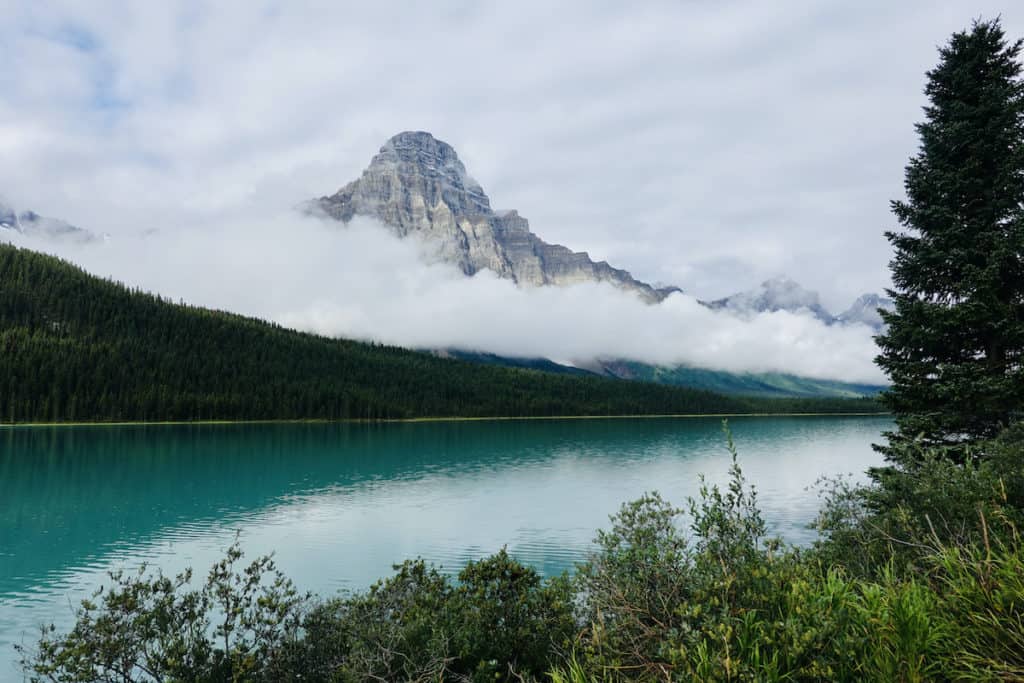
Comments
Please feel free to share your experiences on a Canadian Rockies and/or a Rocky Mountaineer journey. Your ideas may help fellow travelers. 🙂

